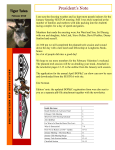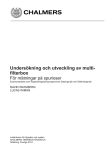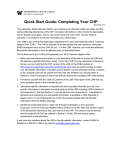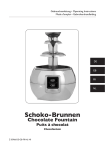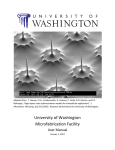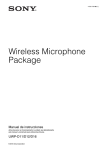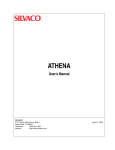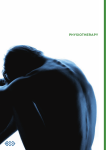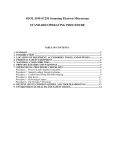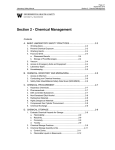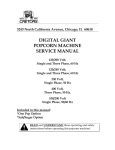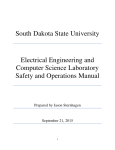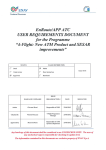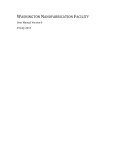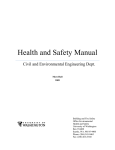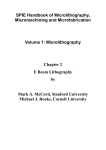Download Health and Safety Plan - UW NNIN Washington Nanofabrication
Transcript
HEALTH AND SAFETY PLAN Revision History April 23, 2010 by PST August 10, 2010 by PST February 01, 2011 by PST TABLE OF CONTENTS A. 1. INTRODUCTION: ...................................................................................................... 1 Scope: ............................................................................................................................... 1 2. Health and Safety Policy:.................................................................................................. 1 3. Responsibility: .................................................................................................................. 1 4. Safety Coordinator: .......................................................................................................... 2 1. FUNDAMENTALS: 8 KEYS ......................................................................................... 2 New Employee Health and Safety Orientation: ............................................................... 2 2. Emergency Evacuation and Operations Plan (EEOP): ...................................................... 3 3. Accidents: ......................................................................................................................... 3 4. First Aid Kits and CPR Given: ............................................................................................ 7 5. Safety Problems: Reporting and Resolving: ..................................................................... 8 6. Safety Meetings: Supervisor Leadership .......................................................................... 8 7. Health & Safety Committee Participation:....................................................................... 9 8. Safety Bulletin Boards .................................................................................................... 10 1. ACCIDENT/ILLNESS PREVENTION: 6 KEYS: ............................................................... 10 Identification of hazards: ............................................................................................... 10 2. Reduction of hazards:..................................................................................................... 13 3. Safety Inspections .......................................................................................................... 15 4. First Aid and CPR Training .............................................................................................. 15 5. Safety Training: On-Going .............................................................................................. 15 6. Medical Exams and Vaccinations ................................................................................... 15 1. DOCUMENTATION AND FOLLOW-UP ...................................................................... 16 Record-Keeping .............................................................................................................. 16 2. Updates: ......................................................................................................................... 16 B. C. D. E. THE SAFE CAMPUS PLAN (new section) .................................................................. 16 APPENDIX A: SMALL Utiity Vehicles & Golf Cart Procedures .................................................... i A. Small Utility Vehicle and Golf Cart Procedures........................................................................ii APPENDIX B: MFL USER MANUAL .......................................................................................... v Revision: February 15, 2011 A. WTC Health and Safety Plan INTRODUCTION: 1. Scope: The policies and procedures in the Washington Technology Center (WTC) Health & Safety Plan apply to the WTC office and IT spaces in Fluke Hall, suites 300, 310, 334, 125, 135, 115B1 &2, 115F, 238. The Health & Safety Plan is publically available to all at the following locations: • Fluke suite 310 (Middle Bay) on the small book case in the NW corner in a labeled binder • The Simplex ECP Panel Room located on the first floor, on the East exterior • The WTC Intranet • The WTC MFL website at http://www.watechcenter.org/lab • For the WTC Microfabrication Laboratory (MFL) procedures (SOP) see appendix “B” and refer to Mike Hjelmstad at [email protected] 206-616-3855 or click the link here: http://www.watechcenter.org/sites/default/files/docs/labusermanual.pdf ttp://www.watechcenter.org/lab 2. Health and Safety Policy: This Accident Prevention Program, or Health and Safety Plan, shares the commitment of the University of Washington to provide a “safe and healthful environment for all individuals associated with the institution, including faculty, staff employees, hospital patients, and visitors” (University Handbook Vol. IV, Part VI, Chapter 4). It follows UW policy set in the Administrative Policy Statements (APS) 10.3, and is consistent with requirements in the Washington State Industrial Safety and Health Act (WISHA) (WAC 296-24, 296-62 and 296-800) which is administered by the Department of Labor and Industries (L&I). 3. Responsibility: The Dean, Director, Chairs and Supervisors are responsible for maintaining safe work practices in their respective units, including required health and safety training. We understand that it is University policy that this responsibility can neither be transferred nor delegated (University Handbook, Vol. IV, Part VI, Chapter 4, Section 1.A). Our department requires all employees to comply with health and safety regulations, with departmental policies and procedures that apply to their own conduct on the job, and to report accidents, injuries, and unsafe conditions to their supervisor. Page | 1 Revision: February 15, 2011 WTC Health and Safety Plan 4. Safety Coordinator: We have chosen one individual to serve as a Safety Coordinator for our department (see “Back Page”). This person is the WTC Facilities Coordinator, Pamela Thomas, and has been given adequate authority to carry out the following responsibilities: • Promoting this Health & Safety Plan in our organization • Updating this Plan, at least annually, with management approval • Assist with scheduling employee safety training as requested by supervisors (special note: lab orientations, safety training and training tracking is coordinated with the lab manager as named in the beginning of this document. University required staff training and training tracking is coordinated through the WTC H/R appointed person, Teresa Rainwater.) • Coordinating with UW Environmental Health & Safety (UW EH&S) • Provide assistance to supervisors and employees as needed to resolve safety complaints • Keeping safety bulletin boards current • Maintaining our organization’s safety records • Keeping the department head aware of current safety concerns. B. FUNDAMENTALS: 8 KEYS 1. New Employee Health and Safety Orientation: WTC HUMAN RESOURCES: All our new employees, including those that are permanent, temporary, or part-time, must receive instruction for the following: a. Reporting procedures for fire, police, or medical emergencies; b. Evacuation procedures during an emergency; c. Location of fire alarm pull-stations and fire extinguishers; Employees using fire extinguishers are recommended to take fire extinguisher training; d. Procedures for reporting all accidents and incidents to their supervisors and completing a written online report using the UW Online Assisted Reporting System (OARS) e. Procedures for reporting unsafe conditions or acts to their supervisors, and, when possible, taking action to correct unsafe conditions; f. Exact location of first-aid kits and identification of first-aid certified employees; LAB MANAGER: g. Description of UW and departmental Hazard Communication Program for chemical hazards to which they may be exposed; h. Identification and explanation of all warning signs and labels used in their work area; i. Use and care of any personal protective equipment they are required to use; j. Description of safety training they will be required to attend for their job. This includes General Asbestos Awareness Training which is mandatory for all employees. Page | 2 Revision: February 15, 2011 WTC Health and Safety Plan The following procedures describe how we provide the above instruction, how and where records are kept, and what person is responsible for providing training. Samples of checklists we use are included (or referenced) here. All new WTC employees must complete a review then sign, date and check off the Health & Safety Orientation with Human Resources for the applicable section(s) above upon new hire orientation. Administrative records are kept with WTC H/R. Further lab training is kept with the WTC MFL lab manager and UW EH&S training records. 2. Emergency Evacuation and Operations Plan (EEOP): The WTC EEOP is based on Fluke Hall as containing several combinations of non-related, multi- disciplinary public and private entities The WTC EEOP contains: a. Building floor plans that show safety equipment and exit pathways; b. Evacuation procedures; c. Evacuation assembly point(s); d. Methods for accounting for staff, students, visitors; e. Areas of refuge for mobility-impaired occupants. For more information, you may call the UW EH&S Building and Fire Safety Office at 206.543.0465. All department staff must be trained in the EEOP. The WTC EEOP is provided to all Fluke lab managers and PIs for them to ensure their departments are trained and adhere to the WTC EEOP. If an employee moves to a new location, the EEOP for their new location must be reviewed for that particular new work site. 3. Accidents: a. Medical Emergencies: All medical emergencies must be reported to the nearest Emergency Medical Services (EMS), usually 911. Our department uses the following method to summon EMS help. WTC staff and Fluke Hall occupants use 911 to summons EMS help. If using cell phone, dial 911 then tell the dispatcher you are on the University of Washington campus (Seattle) and the nature of the emergency. For fire, pull the red alarm then call 911. For hazardous chemical spills, pull the yellow alarm in the MFL or the red outside MFL then call 911. Perform evacuation procedures in the WTC EEOP. A “Blue” Emergency Kiosk phone is located on the ground-level, north exterior promenade of Fluke Hall. Harborview Medical Center Emergency dial 3000 b. Motor Vehicle Accidents For motor vehicle accidents, please see Fleet Services Page | 3 Revision: February 15, 2011 WTC Health and Safety Plan If an Employee is injured, report using Online Accident Reporting System (OARS) Report form to supervisor and EH&S: All accidents and near misses must be reported to the employee’s supervisor and EH&S as soon as possible. Near misses are valuable opportunities to correct unsafe situations, which under slightly different circumstances, would result in serious injury. A report may be filled out by the employee, the supervisor, or both using the Online Accident Reporting System (OARS) at: http://www.ehs.washington.edu/ohsoars/index.shtm. Copies of this department’s completed forms are distributed to the following people: • Immediate supervisor of the party involved • UW EH&S • WTC Facilities Coordinator & Safety Representative, Pamela Thomas Accidents and Incidents Reporting an Accident, Incident, or Near Miss Report all work-related injuries and illnesses or near-miss incidents to your supervisor as soon as possible. For WTC, report to Facilities Coordinator. Accident reports need to be submitted to UW Environmental Health and Safety (EH&S) within 24 hours. In case of serious or fatal accident or hospitalization, notify EH&S immediately at 543-7262 (within 8 hours); after hours contact the UW Police Department (UWPD) Dispatch by dialing 911 in order for the EH&S Staff On Call to be notified. Do not move any equipment involved in these types of serious accidents until EH&S has clearance from State investigators. If the WTC Facilities Coordinator is unavailable within the needed timeframe for reporting, call EH&S at the above number for assistance with the OARS reporting. Upon completion of incident reporting, notify the WTC Facility Coordinator and the immediate supervisor of the incident via e-mail, phone or in person as soon as possible. Enter the Online Accident Reporting System (OARS) Reporting a Fire “Fire” is defined as any instance of open flame or other burning in a place not intended to contain the burning. All fire emergencies and explosions must be reported immediately regardless of size and nature by phoning 911 and/or activating the fire alarm system. The level of response will vary based upon the information provided. To comply with agency reporting requirements, all incidents including minor fires that self-extinguish and those that do not require emergency assistance or evacuation must be reported to EH&S within 24 hours. EH&S investigates all fires to determine their cause, provide consultation and to document the incident for reporting purposes. Please call (206) 616-5519 or email [email protected] to report fires/explosions to EH&S. Page | 4 Revision: February 15, 2011 WTC Health and Safety Plan Reporting Chemical Spills Spills Management Emergency Contacts Major Spills If you have a spill, and the spill is uncontained and endangering other people and/or has the immediate potential to cause a fire pull the nearest fire alarm to evacuate the building and alert the local Fire Department. The fire alarm is the fastest way to evacuate the building and get help. Minor Spills If the spill is contained and there is no potential for fire, but the spill has caused or will likely cause injury, call emergency personnel using the numbers below. Your location Phone number All UW campuses and UWMC 911 Cell or off campus phone 911 Harborview 3000 or 911 You will be asked about your location, the size, type and risks of the spill, and the details of the injury. Exposure Assessment If you have been exposed to a spill and are not sure whether or not you should seek medical attention, you should request an exposure assessment from Hall Health. Location Phone number Employee Hall Health Clinic 206.231.3081 Campus Health Clinic (for students) 206.685.1026 Spills cleanup If the spill is contained and there is no immediate risk of injury, then decide whether or not you will be able to clean up the spill yourself: Cleanup If you do not have an emergency but you need technical assistance with spill cleanup or Page | 5 Revision: February 15, 2011 WTC Health and Safety Plan an outside contractor to do the cleanup for you, call EH&S spill advice line at 206.543.0467 during business hours. After hours, wait until the next business day or call 206.685.UWPD from any location and ask to speak to "EH&S Staff On Call". Call 206.543.0467 for assistance with spills that fill your laboratory with toxic vapors. You cannot clean up these spills yourself. The use of respirators requires prior medical evaluation, training, and fit testing, and even if you have been trained, you are not allowed to do cleanups because the vapors may overwhelm the respirator, which are often designed only for normal use. You can clean up the spill yourself if you know what chemical was spilled and that hazards of that chemical, can you protect yourself from these hazards (with gloves, eye protection etc), and have and know how to use a chemical spill kit for that chemical. EH&S has created a custom general purpose spill kit for spills up to about a gallon in volume. The spill kit contains materials that neutralize an acid spill and absorb small amounts of liquids. It also contains handy items such as goggles, gloves and hazardous waste labels. It is available at Chemstore, 206.543.1728, and Biochemistry Stores, 206.543.1624, and you can order it from VWR through eProcurement (part #TXGENERALSPILL) for $50. The spill kit contains the following: Containers and Protective gear supplies Five spill pads, 1 box baking soda for 4, 20 x 30", heavy 1 pair Silvershield gloves, universal for acid, neutralizing acids duty (6mm) protective against most base, solvents and (neutralizes about two hazardous waste chemicals oil (absorbs about liters of concentrated plastic bags 5 liters of liquids) acid, half that if dibasic) 1 five gallon 1 pair goggles reuseable screw top plastic drum. Use to store all kit supplies and later to hold spill waste for pickup by EH&S. Snap together dust 8 pairs of Microgrip pan and brush powder free nitrile gloves Waste collection form and labels (available free from EH&S) Chemical spills: http://www.ehs.washington.edu/epo/spills/chemspills.shtm Radioactive spills: http://www.ehs.washington.edu/rsoemerinfo/spills_rad.shtm Absorbents Neutralizing material Page | 6 Revision: February 15, 2011 WTC Health and Safety Plan Biohazardous spills: http://www.ehs.washington.edu/rbsbiosafe/spillsbio.shtm Mercury spills: http://www.ehs.washington.edu/epo/spills/hgspills.shtm Oil spills: http://www.ehs.washington.edu/epo/spills/oilspills.shtm Call the following numbers for assistance in writing spill procedures: Type of Spill Phone number Chemical, mercury or oil 206.543.0467 Biological 206.221.7770 Radioactive 206.543.0463 Finally, don't work alone if possible, especially on weekends when no one else is there to help you in the event of an emergency. c. Investigation: All accidents and near accidents must be investigated by the supervisor who then summarizes the details and corrective measures in the above report. EH&S and the department’s organizational safety committee review the report. Assistance from EH&S is available by calling 206.543.7388. 4. First Aid Kits and CPR Given: Quick and effective first-aid for an injured University employee results from the availability of strategically located first-aid kits and first-aid/CPR certified individuals whenever department staff are working. Adequate employee access to these resources is addressed in this section. a. Department First Aid Consistent with the UW First Aid Response Plan (APS 10.5), certified first-aid and CPR assistance is available to department employees by contacting UW Emergency Response Teams. Related department training requirements are addressed later in section C.4 First Aid and CPR Training. Names and phone numbers of employees who are first-aid/CPR certified are listed on the “Back Page” of this document and on the outside of first aid kits. b. First Aid Kits Locations and sizes of first-aid kits in our department are listed below. First-Aid Kits are inspected periodically so they can be restocked before running out of an item. Names and phone numbers of those employees who are CPR trained and those employees who are responsible for first-aid kits are listed on the outside of the kits and on the “Back Page” of this document. Page | 7 Revision: February 15, 2011 WTC Health and Safety Plan The WTC office red first aid kit hard cover case labeled “First Aid” on the outside is located on the third floor south, in the small kitchenette, and at the right side of the Microwave. It is inventoried and stocked by the WTC Facilities Coordinator & Safety Representative, Pamela Thomas. The WTC first floor lab kit is located in 135. 5. Safety Problems: Reporting and Resolving: Employees are encouraged to report safety concerns to their supervisor. If employees do not feel they can do this, or have done so and do not feel the problem has been resolved, they may discuss the situation directly with their safety coordinator or safety committee representative. Assistance from EH&S is available, if needed, to resolve a problem. Safety problems may be reported online using OARS as you do for accidents/incidents. Other departmental procedures for reporting and resolving safety problems or potential workplace violence are described below: Call 911 If safe yet concerned, report threats to Safe Campus at 206-685-SAFE (7233) Additional resources can be found at UW Care Link http://www.washington.edu/admin/hr/benefits/worklife/carelink/index.html For UW safety guards, call 206-685-WALK (9255) Refer to Workplace Violence Reporting here: UW Policy and Procedure on Workplace Violence File Online Accident Reporting System (OARS) if injured. University Medical Centers Employees Report to Public Safety Office Complete a PSN report. Complete an OARS report. University of Washington Medical Center Public Safety 6. Safety Meetings: Supervisor Leadership Supervisors can promote health and safety in formal safety meetings or in regular staff meetings, but either way, discussion of safety issues needs to be documented. Formal safety meetings are held as described below, including organizational policy, meeting frequency, responsibility for minutes, location of minutes, and how part-time employees can participate or be informed. WTC Facilities & Safety Coordinator keeps safety committee notes available to all staff. Updates and noteworthy information, such as new training links and news, is communicated via e-mail with staff and Fluke tenants directly. Other non-urgent information is communicated via the initial orientation and staff meetings as issues arise. (Staff meetings are weekly) Page | 8 Revision: February 15, 2011 WTC Health and Safety Plan Training updates are conducted annually or as needed in context. Annual asbestos awareness training notifications are sent to all employees and student help via e-mail instructions referring to the training link: https://www.ehs.washington.edu/pubcookie/train/asbestosg/index.shtm This was last coordinated October 7, 2010 by the Safety Coordinator. * For WTC MFL specific procedures and training, refer to the lab manager, Michael Hjelmstad at [email protected] 206-616-3855 For procedures in general, the following applies: WTC is a small organization of 18 – 22 employees at any given time, many of whom work from remote posts at any given time. Facilities Coordinator & Safety Representative, Pamela Thomas, assists with training notifications and information processing. WTC H/R, Teresa Rainwater archives training for office staff. MFL Lab Manager, Mike Hjelmstad assists with training notifications and information processing and archiving for lab staff. A generic new employee safety orientation checklist can be found on the EH&S website at http://www.ehs.washington.edu/ohshsplans/index.shtm. 7. Health & Safety Committee Participation: Health & Safety Committees at three organizational levels help determine unsafe conditions and procedures, suggest corrective measures, and obtain the participation of all UW personnel. At the Organizational and University-Wide levels, fifty percent (or more) of the representatives are elected by employees and fifty percent (or less) are appointed by management. Safety issues may originate at any level. Health & Safety Committees are required by Washington State regulation (WAC 296-800-14005). A listing of committees and current members may be found at the EH&S web-site: www.ehs.washington.edu (click on Safety Committees). a. Departmental Health and Safety Teams Departmental Health & Safety Teams deal with “front line” issues. Large departments may especially benefit from this centralized approach to health and safety issues. In addition to providing a pathway for communication between different sections, teams involve employees in the process of identifying and resolving safety issues. WTC does not have a formal health and safety team. Instead, health and safety issues are discussed in staff meetings (see section B.6) and as part of our Organizational Health & Safety Committee. Also, a student or staff member can approach the WTC safety representative, Pamela Thomas, at any time. b. Organizational Health and Safety Committees Page | 9 Revision: February 15, 2011 WTC Health and Safety Plan The University is divided into eleven organizational groupings, each one represented by an Organizational Health and Safety Committee. This committee deals with issues the members may have in common but can handle more effectively together. Each elected member represents all units of that organizational group, including his/her own. Our department is represented on the Group # 9 Organizational Health & Safety Committee. The Group # 9 Committee reports to the following executive Michael Glidden of College of Engineering, who is represented on the Committee by __Michael Merrill of UW EH&S. Our current representatives are identified on the “Back Page” of this document. c. University-wide Health and Safety Committee In addition, to provide consistency and oversight, a University-wide Health and Safety Committee has been established. Its members come from the official organizational committees. Safety issues referred to this level are relevant to the entire University community. The member(s) who currently represent us from the Group # _9_ Organizational Health & Safety Committee are listed on the “Back Page” of this document. 8. Safety Bulletin Boards Our departmental safety bulletin boards are used for posting DOSH (formerly WISHA) posters. Safety posters, notices and safety newsletters are posted on the third floor bathroom corridor in the middle of the hallway. Safety committee minutes and incident reports are kept on the third floor in binders on a bookcase at the WTC Facility Coordinator desk. Accident statistics and other safety education material may also be posted. WTC Lab training schedules are located in first floor 135 MFL lab for WTC where all employees, students, and visitors can see them (WAC 296-800-19005) and at all University reference stations. C. ACCIDENT/ILLNESS PREVENTION: 6 KEYS: 1. Identification of hazards: This is the foundation for our Accident Prevention Program. The boxes we have checked in the following chart, “Typical Work Site Safety Issues To Address,” indicate health and safety concerns present in our own department. • We consulted knowledgeable staff to identify possible hazards. • We reviewed records of past injuries to understand their causes. • We developed Laboratory Safety Manuals for our laboratories (including Chemical Hygiene Plans) if required. Page | 10 Revision: February 15, 2011 WTC Health and Safety Plan • We visited all work areas, and examined processes from beginning to end in order to record possible hazardous situations. • We developed inspection checklists (see section C.3 below). • We applied recommendations from inspectors outside our department, such as EH&S. • We consulted the Washington Administrative Code (WAC) Chapters 296-24, 296-62 and 296-800 for General Safety and Health Standards and Occupational Health Standards established by the State Department of Labor and Industries (L&I), as well as the University of Washington Administrative Policy Statements (APS), 10.3. • We performed Job Hazard Analyses (JHA). (See discussion following the Chart below.) “Typical Worksite Safety Issues to Address” Chart Instructions The chart on the next page is a tool to help you identify issues that are addressed by safety regulation. You don’t have to include the actual chart in your Plan, but it would be a good idea to do so when requirements apply to your workplace. (Double left-click on any box in the left column you want to check.) Safety items you have checked indicate issues you need to evaluate. These must be included in your safety Plan, along with methods you have developed to reduce a hazard if one exists. Section C.2 Reduction of Hazards explains how to do this. EH&S help at 206.543.7388. Check All That Apply Typical Worksite Safety ClassIssues To Address Offices rooms Applies: A=Almost Always, B=Commonly, C=May Apply, Blank=Rarely Applies Hosp. / Clinics Labs Shops X Emergency Procedures: Fire, Other (EEOP) A A A A A X Earthquake Preparedness A A A A A X Housekeeping Hazards A A A A A X Slip/Trip Hazards A A A A A X Electrical Equipment & Wiring A A A A A X Emergency Escapes (Egress) Maintained/Unlocked A A A A A X Obstruction-Free Aisles Stacks of Stored Materials (Stable/Secure) Temperature Extremes: Heat/Cold Stress HazCom Right-To-Know (Written Program In Place) Air Contaminants, Dusts, "Inert" Gases, Vapors A A A A A A A A A A A A A A A A A A A A A A A A A Asbestos (Present or Handled) Lifting >20 lbs. Repetitive Motion, Ergonomics Motor Vehicles Hand or Portable Power Tools Ladders Knives or Cutting Blades Compressed Gas or Equipment Hazardous Waste Haz-Mat Spills: Operations, Emergency Response A A A A B B B A A B A B B C A A A A A A B A A A A A A A A A B A A A A A A A A A A A A A A A A X X X X X Page | 11 C Revision: February 15, 2011 X X X WTC Health and Safety Plan Hazardous Materials Stored/Shipped/Transported Laboratory Chemicals Radioactive Materials Used or Stored Personal Protective Equipment (PPE) Respirator Protection, Workplace Evaluations Bloodborne Pathogens/Biohazards/Infectious Waste Welding, Cutting, Brazing Machinery (Machine Guards) Lock-Out/Tag-Out Confined Work Spaces / Oxygen-Deficiency Steam or Autoclaves Lasers or UV Light Flammable Liquids (Handled or Stored) Formaldehyde (Handled or Stored) Carcinogens Lead or Benzene (Handled or Stored) Animals (Handled or Kept) Loud Noise Vibration From Tools/Machinery Heights > 4 Ft. (Possible Falls) Cranes, Hoists, Derricks, Rigging Powered Platforms (Personal Lifts) Forklifts Scaffolds Excavation, Trenching or Shoring Activities BBQs Food Handling Diving C C B B A B B B B B C C C C A A A A A A A B A A A B B B B C C C C C C C C C C C A A A A A A A A B C A A A A A A A A A A A C C C C A Job Hazard Analysis may be performed by the first line supervisor in the following way: • • • • • • • • • Review job injury and illness reports (including “close calls”) to determine which jobs to analyze first. Involve employees in all phases of the analysis. Explain to workers that you are studying the job, itself, not checking up on them. Review work plans for an overview of job activities. First note deficiencies in general conditions, such as inadequate lighting, noise, or tripping hazards that may not be directly related to the job. Break the job down into steps in the order of occurrence. Examine each step to determine hazards that exist or might occur. Determine whether the job could be performed in another way or whether safety equipment or precautions are needed. If safer job steps can be used, write new procedures to describe specifically what the worker needs to know to perform them. Determine if any physical changes will eliminate or reduce the danger (e.g. redesigned equipment, different tools, machine guards, personal protective equipment or ventilation). Page | 12 A A A A B A A A C A A C A A A A A A A A B Revision: February 15, 2011 • • • • WTC Health and Safety Plan If hazards are still present, try to reduce the necessity or frequency for performing the job. Document the assessment: job covered, task, date, and person performing the analysis. Review recommendations with all employees performing the job. Review and update the job hazard analysis periodically, especially if an accident occurs in that job. 2. Reduction of hazards: Our department head and supervisors have complied with the requirement for a written plan in their areas of responsibility by identifying each of the above hazards, evaluating its potential risk, and controlling or eliminating it according to the measures described below. When possible, we modified or designed our facilities and equipment to eliminate employee exposure to hazards. Where engineering controls are not possible, we have instituted work practice controls that effectively prevent employee exposure to the hazard. When these methods of control are not possible or not fully effective, we require the use of personal protective equipment (PPE), such as safety glasses, hearing protection, etc. a. Evaluation Evaluation of potential risk (probability and magnitude of harm) has been done for certain hazards. When hazards are either (1) present in an unknown or a variable amount (such as airborne contaminants like asbestos or carbon monoxide), or (2) subject to complicating factors (such as extreme risk or individual medical sensitivity), monitoring has been done to determine the safest procedures. EH&S has been consulted as needed. The following describes evaluations we have made: Refer to the MFL Lab Manual, appendix “B”, attached to the back of this document. b. Engineering Controls Engineering controls have been employed, whenever possible, as the preferred way to eliminate the following specific hazards (facility or equipment design, e.g., fume hoods, guardrails, proper tool guards, walkway surfacing). A building- wide Emergency Communication Panel (ECP) system and an additional lab ECP relay emergency information to the UW fire department, City of Seattle fire department, City of Seattle hazardous response teams and the WTC MFL manager via dedicated data lines that report to a signal response relay system. These ECP’s are synchronized with the building fire alarm systems, thus activating all simultaneously in a fire and safety emergency. Other phone numbers: • Symplex monitoring Systems: Page | 13 Revision: February 15, 2011 WTC Health and Safety Plan o The “silent night” auto dialer on the sensor Emergency Communications Panel (ECP) that services the MFL and can also sense other hazardous gases in the parameter of the sensor is 206-685-6641. This number dials from the University to Simplex using 206-685-6752 and is digitally recognized for emergency alert. This sends out appropriate UW FOMS, Fire and Haz Mat signals for the degree necessary for the type of alarm. This system is approved for the indications and response relay. • • • • Mike Hjelmstad, WTC MFL lab manager emergency cell: 425-894-6243 UW FOMS: 685-1411- ask for 24/7 EH&S assistance via FOMS UW Environmental Health & Safety: 206-543-7262 “Silent Night” auto dialer dedicated phone lines o 206-685-6641- primary o 206-685-6752- alternate back up c. Administrative Controls Administrative controls, the way a job is done, have been used to reduce some of the hazards in our department, and on-going training is an inherent part of our safety program (see section C.5). EH&S inspections are conducted by the UW official respective representatives on a semi- annual basis. Building fire systems checks are conducted by the UW official respective representatives on an annual basis. Fire Drills for EEOP are conducted by UW Fire Safety quarterly. Building walkthroughs are conducted at random by the Facility Coordinator & Safety representative. Lab PI’s are responsible for checking and reporting for training and compliance on an ongoing basis. d. Personal Protective Equipment None required for administrative staff. For the WTC MFL lab, please refer to appendix “B” attached to the back of this document. Hazard assessment and training documentation is also located in the WTC MFL lab room# 135 for lab staff and users. The University of Washington EH&S team provides support with on-site staff in an emergency when other PPE is required outside of the lab manual. The following information is required (UW APS10.4): Hazard Assessed, (site, evaluator, date, supervisor verifying) For WTC, every new lab user is provided with the LAB SOP Safety Manual and is responsible to apply the information at all times while using the lab. New information and updates are provided as required on an ongoing basis. For other lab tenants in Fluke Hall, their respective on-site lab supervisor is responsible for managing their lab safety as required in this document. Their training records are to Page | 14 Revision: February 15, 2011 WTC Health and Safety Plan be on file with UW EH&S Training and their on-site lab supervisor in their respective room/lab in Fluke to be accountable for by their respective college department. 3. Safety Inspections Safety Inspections for WTC and Fluke Hall are conducted semi-annually by the UW EH&S staff. They send a report with recommendations to the WTC Facilities Coordinator for issues concerning WTC third floor administrative areas and to each lab manager in Fluke for individual labs. They then check back in three weeks to be sure all requirements and recommendations are met. Each lab manager in Fluke is responsible for their compliance. 4. First Aid and CPR Training Names and phone numbers of employees who are first-aid/CPR certified are listed on the “Back Page” of this document. The UW Police Department provides adequate access to emergency first aid for our employees (see section B.4). Consequently, we do not require employee training in First Aid and CPR. However, employees are encouraged to take first aid. 5. Safety Training: On-Going To ensure an effective health and safety program, we continually re-educate employees on how to work safely with all applicable hazards. Supervisors are responsible for this training and for seeing that safe practices are followed. Listed below are the training requirements for hazards identified in our department, how training is obtained, and how often it must be renewed Training records, including completion dates, are kept to maintain program continuity and to satisfy legal requirements. Documentation is kept by UW EH&S- training records division for WTC and non-WTC lab users. Hazard Type of Training Frequency Person/Position Workplace violence training is required for all-staff by the University upon hire. These records are kept by the University H/R systems. WTC lab staff requirements- see appendix “B” attached to the back of this document. Additional information regarding training requirements may be found on the EH&S home page under “Training Information”. Supervisors are encouraged to attend EH&S training for hazards faced by employees in their areas of responsibility. The class “HazCom Train-the-Trainer,” for example, would apply to most work places. 6. Medical Exams and Vaccinations WTC administrative staff- N/A WTC lab staff- see appendix “B” attached to the back of this document. Page | 15 Revision: February 15, 2011 D. WTC Health and Safety Plan DOCUMENTATION AND FOLLOW-UP 1. Record-Keeping To meet State requirements, our department maintains records of safety activities for varying lengths of time depending upon the type of record, and is able to produce them when requested by EH&S or L&I. Note: the EH&S Training office maintains records for EH&S classes. Call 206.543.7201 for more information. Department records should include: Results of self-evaluation inspections. Records of requests for assistance in correcting noted deficiencies. Minutes of safety education-accident prevention meetings. Backup records of the above set are kept in labeled binders, on a bookcase, in the WTC facilities coordinator desk area. Records of employees requiring medical evaluations including dates of examinations and immunizations. Records of employee safety training, including dates when certificates expire, where applicable. Backup records of the above set are kept in the MFL lab 135 by the WTC lab manager. All records are on file with University of Washington EH&S. WTC has the right to elicit assistance from UW EH&S to procure records upon request. 2. Updates: For this Plan to be useful as a “living document,” it must reflect the department’s current safety program and its current responsible parties. Periodic updates, at least annually, are necessary to ensure this. The “Back Page” of this document provides a convenient place to look for the most recent revision date, the names of key safety personnel, and other information. E. THE SAFE CAMPUS PLAN (NEW SECTION) While there are specific regulatory requirements for hospitals and late night retail operations regarding workplace violence that don't apply to general University operations, we do recognize that individual attacks on faculty, staff and students can and have occurred due to domestic violence or workplace violence. As part of maintaining a healthy, safe working environment, the University has developed and administers one UW Violence in the Workplace Policy and Procedure through the Human Resource's Violence Prevention and Response Program. Information on the program/policies is published on the UW website at http://www.washington.edu/admin/hr/polproc/work-violence/index.html. University services include nighttime safety escort services, counseling sessions, a dedicated assessment team, and informational materials and training, but services are not limited to these items. Page | 16 Revision: February 15, 2011 WTC Health and Safety Plan All managers, supervisors, and employees must be aware of the appropriate processes to follow regarding workplace and domestic violence prevention. They can receive assistance in answering any employee questions from the HR Violence Prevention and Response Program Manager. We expect our entire faculty and staff to take Workplace Violence training at least once every biennium, as well as receive information during new employee orientation. We arrange for the biennial training [fill in the method used by your work group]. Records of the training are maintained in the [give location] Office. For more comprehensive information, access the SafeCampus website at http://www.washington.edu/safecampus. If any staff has concerns regarding a threat of violence, call: Seattle: 206-685 SAFE (206-685-7233) Bothell: 425-352-SAFE (425-352-7233) Tacoma: 253-692-SAFE (253-692-7233) In a life threatening situation or imminent danger call 911, immediately! Page | 17 Revision: February 15, 2011 WTC Health and Safety Plan “Back Page” 1. Department: Washington Technology Center (WTC) 2. Today’s date / signature: 01 February 2011 __pamela thomas 3. Last update (date/person): 23 April 2010 3. Health and Safety Coordinator for our department: (from _2010 to 2012): Name __Pamela Thomas Phone _206-221-7132 E-mail [email protected] Bldg./Room/Box # ___Fluke Hall/ #310 / BOX 352140 4. Health and Safety Team members in our department: For WTC lab: Mike Hjelmstad- MFL lab room 125 & 115B2 5. Organizational Safety & Health Committee: Group #9, Helath & Safety Committee Organizational Safety & Health Committee: 6. Group #9, Health & Safety Committee Elected: Name/e-mail/phone 2010 to 2012 ) N/A (from Appointed: Name/e-mail/phone Pamela Thomas [email protected] 206-2217132(from 2010 to2012 ) Union Representative: Name/e-mail/phone N/A (from 2010 to 2012 ) Chair: Name/e-mail/phone Ron Fouty 206-221-3350 (from 2010 to 2012 ) University-Wide Safety & Health Committee representative for above Gr. #9: Name/email/phone Jack Herndon 206-543-2547 (from 2010 to 2012) 7. First-Aid/CPR Certified employees in our department: Name/Phone/Expiration Date Pamela Thomas/ 206-221-7132 / Dec 2, 2011 Person responsible for stocking First-Aid Kits (UW APS 10.5): Pamela Thomas for WTC Administrative, 3rd Floor Mike Hjelmstad for WTC MFL Lab 135/ 115B2 8. Important Non Emergency Phone Numbers: WTC main line: 206-685-1920 WTC reception: 206-685-1922 See EH&S web-site at www.ehs.washington.edu Click on “Service Phone Numbers” Page | 18 Revision: February 15, 2011 WTC Health and Safety Plan WTC Quick Reference Sheet Fire/ Chemical Emergencies • In case of fire and chemical emergencies, call pull the nearest fire alarms, call 911, tell them if you are on the UW Campus and follow the Emergency Evacuation Plan Refer to Lab Manual for chemical emergencies Other Facility Emergencies • Call FOMS 206-685-1411 • Notify WTC Facilities Manager Accident/ Injury Reporting • For medical emergencies, call 911 • Report all accidents and injuries to the WTC Facility Manager. The Facility Manager will then request your assistance to fill out information on the OARS online report and perform follow through according to respective requirements. • Accidents/ Injuries requiring medical assistance must be reported to EH&S within 8 hours. If no one is available to assist you in the OARS reporting, call EH&S at 206-543-7262. Refer to the web link for Accident and Incident reporting here for further assistance: http://www.ehs.washington.edu/ohsoars/index.shtm • Non medical accident/ injuries must be reported within 24 hours Work Place Violence • Call 206-685-SAFE • File Online Accident Reporting System (OARS) if injured Motor Vehicle Accidents • Motor Pool Vehicles: see Fleet Services • If an Employee is injured, report using Online Accident Reporting System (OARS) Other - Helpful Links: • UW EH&S: http://www.ehs.washington.edu/ • University of Washington Medical Center • Harborview Medical Center • University of Washington Campuses - Hall Health Center Page | 19 Revision: August 2010 WTC Health and Safety Plan APPENDIX A: SMALL UTIITY VEHICLES & GOLF CART PROCEDURES Appendix |i Revision: August 2010 WTC Health and Safety Plan A. Small Utility Vehicle and Golf Cart Procedures The Washington Technology Center DOES NOT allow the use of golf carts under any circumstances. The following information is provided for visitors and guests of the WTC to build awareness for training issues to follow up with from their rental agent should they wish to use golf carts on their own time, under their own risk and responsibility. These procedures are provided to facilitate safe operation of small utility vehicles and golf carts used during UW operations. Because these vehicles are typically of lighter construction, feature less safety equipment, and operate in different environments than typical motor vehicles, it is imperative that operators understand the particular capabilities and limitations of these vehicles, and that they are aware and take precautions against the particular hazards they may be exposed to. Each department that operates these types of vehicles must adhere with the requirements of this procedure and should have trained staff members who are responsible for supervising operators. Since this procedure may not identify all hazards associated with particular vehicle operations, each department is responsible for conducting a “job hazard analysis” to determine the potential hazards for their specific operations and operating conditions (for example, crowded stadiums, steep slopes, or severe weather) and to take appropriate action to mitigate any particular hazards identified in that analysis. Departments are also responsible for ensuring that vehicles are maintained in a condition that allows for safe operation. This procedure is for small utility vehicles and golf carts only, and is not intended for typical automobiles, trucks, or vans, or for riding lawnmowers, tractors, etc. This procedure does not replace or invalidate any other requirements or rules governing use of UW vehicles or equipment. 1. Definitions: a. Golf Cart: Small motorized vehicle with room for a driver, one or more seated passengers, and a small amount of equipment, generally not licensed for street use. b. Small Utility Vehicle: Small motorized vehicle designed for a specific type of work, such as a Cushman, a John Deere Gator or Kawasaki Mule, etc. These vehicles are mainly intended for off-street use, although they may be licensed for street usage. They are generally designed to carry equipment and/or passengers. c. Street Legal: A small utility vehicle or golf cart that meets the requirements of the State of Washington to be able to be driven on public roads according to the appropriate RCW and WAC sections and has been approved for such use by the manufacturer. A p p e n d i x | ii Revision: August 2010 WTC Health and Safety Plan d. Trained Staff Member: UW employee who has been received training on the elements of this procedure and who is authorized by their department to supervise golf cart and/or small utility vehicle operations. 2. All drivers of utility vehicles or golf carts must attend a training session prior to operating any such vehicles, and must be a trained staff member or under the supervision of a trained staff member while operating vehicles. The training program should include: • The contents of this procedure, especially including all safety rules. • Safe operating rules of the road. • Precautions for operating in low-light or dark conditions. • Designated paths and routes for vehicle operation. • Procedures for unusual operating conditions, for example, while using an attached snow plow or towing, as applicable. • Limitations and restrictions on the use of the golf cart. • The difference between street legal and non-street legal golf cart/small utility vehicle. • Steps to be taken in an emergency. 3. All drivers must be 18 years of age or older and must have a valid driver’s license. A copy of the current valid driver’s license should be on file with the responsible department prior to operating the vehicle. Each department should designate an HR representative to keep this confidential information on file. 4. Utility vehicles and golf carts shall observe all vehicle traffic laws (e.g. stopping at stop signs, yielding to pedestrians, etc). 5. Vehicles shall not be operated in a manner that may endanger passengers, other members of the campus community, or property. Drivers must not be under the influence of alcohol or drugs. Drivers should not use radios or cell phones while the vehicle is moving. Absolutely no horseplay while operating vehicles. 6. The number of passengers and load capacity shall not exceed the manufacturer’s rated limit. Passengers must be in seats. Seatbelts must be worn, if installed. Safety equipment, especially including seatbelts, may not be removed from the vehicle. 7. Driver and passengers must hold on to the utility vehicle or golf cart at all times while the vehicle is in motion unless securely seat-belted in place. Luggage, packages, cargo, and/or equipment must be adequately secured for safety. 8. Operators must operate vehicles at a safe speed for conditions, and should not operate vehicles at maximum speed. A p p e n d i x | iii Revision: August 2010 WTC Health and Safety Plan 9. Utility vehicles and golf cart-type vehicles that are not licensed for street usage are restricted to sidewalks and paths on the University campus. Street-legal vehicles may be operated on streets with prior approval of responsible department. Small utility vehicles and golf carts must be operated in accordance with all applicable traffic laws, particularly regarding usage of seat-belts and prohibitions against use of cell phones or texting while driving. 10. Check path of utility vehicles or golf carts and identify areas of caution or reduced speeds over designated paths. Drivers should slow when approaching such areas, or if traveling over paths which have not been assessed. Included in training session will be instructions on which paths to use. 11. Operators must reduce speed to match other users on all streets, sidewalks, and paths. In congested pedestrian areas, operators must either park or proceed at a slow walking pace. 12. Vehicles can only be parked in a safe manner and location and must not block any entrances to buildings, stairways, ramps, or thoroughfares. Passengers who are not UW employees should be embarked and disembarked only when the vehicle is parked on a hard, level surface. 13. Charging stations for electric golf carts and utility vehicles shall be located in a safe location that has adequate ventilation to prevent potential build-up of explosive hydrogen gas, and which is adequately protected from weather. 14. Report all work-related injuries or near miss incidents to supervisor as soon as possible. Incident report instructions: http://www.ehs.washington.edu/ohsoars/index.shtm. Traffic and vehicle accidents may also require additional reporting to UWPD, Washington State Patrol, and/or Washington Department of Transportation. A p p e n d i x | iv Revision: August 2010 WTC Health and Safety Plan APPENDIX B: MFL USER MANUAL Appendix |v Adaptedfrom:Y.Hanein,C.G.J.Schabmueller,G.Holman,P.Lücke,D.D.Denton,andK.F. Böhringer,“Highaspectratiosubmicrometerneedlesforintracellularapplications”,J. Micromech.Microeng.,13,S91(2003).ResearchperformedatWashingtonTechnologyCenter. WashingtonTechnologyCenter MicrofabricationLaboratory UserManual October2010 TableofContents 1.0 2.0 3.0 4.0 5.0 5.1. LabManualGoals......................................................................................................1 Introduction..............................................................................................................2 Contacts....................................................................................................................3 LabLayout.................................................................................................................4 Emergency.................................................................................................................5 Expectations.....................................................................................................................5 5.2. MedicalEmergencies.......................................................................................................5 5.3. FireandHAZMATAlarms.................................................................................................5 5.4. ExitRoutes........................................................................................................................6 5.5. FireSuppression...............................................................................................................7 5.6. FacilitiesEmergency.........................................................................................................7 5.7. ChemicalEmergency........................................................................................................7 5.8. SpillResponse/PersonalProtectiveEquipment...............................................................8 5.9. EmergencyManualOff(EMO).........................................................................................8 5.10. ElectricalShuntTrips....................................................................................................9 5.11. CompressedGases........................................................................................................9 6.0 6.1. GettingAccessandGeneralProtocol.......................................................................10 GeneralDisclaimers........................................................................................................10 6.2. HoursofOperation.........................................................................................................10 6.3. GrantingAccess..............................................................................................................11 6.4. AccessCard.....................................................................................................................12 6.5. TerminatingAccess........................................................................................................12 6.6. UserFees/Billing.............................................................................................................12 7.0 7.1. CORAL.....................................................................................................................14 Login...............................................................................................................................14 7.2. CORALClients.................................................................................................................14 7.3. ResourceClient...............................................................................................................14 7.4. EquipmentStatus...........................................................................................................16 7.5. MakingEquipmentReservations...................................................................................16 7.6. EnablingandDisablingEquipment.................................................................................17 7.7. ReportingShutdownsorProblems................................................................................18 7.8. CORALErrorsandAlterations........................................................................................18 7.9. CORALRules...................................................................................................................19 7.10. PenaltiesforCORALViolations...................................................................................19 8.0 8.1. EquipmentUse........................................................................................................21 Training...........................................................................................................................21 8.2. EquipmentCertification.................................................................................................22 8.3. CertificationLapseandRetraining.................................................................................22 8.4. EquipmentExpectation..................................................................................................22 8.5. EquipmentReservations................................................................................................23 8.6. EquipmentMalfunction/UncommonRuns....................................................................24 8.7. OvernightRuns...............................................................................................................24 8.8. ConsumablesfromWTC.................................................................................................24 8.9. PrivilegedAccess............................................................................................................25 9.0 9.1. CleanroomPoliciesandProcedures.........................................................................26 SharedFacility................................................................................................................26 9.2. CleanroomOperation.....................................................................................................26 9.3. LabCleanliness...............................................................................................................26 9.4. Restrictions.....................................................................................................................27 9.5. CleanroomGowningProcedure.....................................................................................27 9.6. Laundry...........................................................................................................................29 9.7. PersonalHygiene............................................................................................................29 9.8. GreyAreas......................................................................................................................29 9.9. Tools...............................................................................................................................30 9.10. CompressedGases......................................................................................................30 9.11. Cryogenics...................................................................................................................31 9.12. BuddySystem.............................................................................................................31 9.13. WaferHandling...........................................................................................................32 9.14. WaferStorage.............................................................................................................32 9.15. DeskSpace..................................................................................................................32 9.16. InternetPolicy............................................................................................................33 9.17. LockerPolicy...............................................................................................................33 9.18. Guest/VisitorPolicy....................................................................................................33 10.0 ChemicalHandling/Processing.................................................................................34 10.1. Facilities......................................................................................................................34 10.2. ReducingWaste/ChemicalUsage...............................................................................34 10.3. ChemicalStorage........................................................................................................35 10.4. MaterialSafetyDataSheets(MSDS)..........................................................................35 10.5. NewChemicals...........................................................................................................35 10.6. PersonalProtectiveEquipment..................................................................................36 10.7. WaferCassettes..........................................................................................................36 10.8. Solvents.......................................................................................................................36 10.9. Acids/Bases.................................................................................................................37 10.10. ChemicalBottleCleanup............................................................................................38 10.11. NonEmergencySpillResponseProcedures...............................................................39 10.12. StaffMaintainedBaths...............................................................................................40 10.13. DedicatedGlassware..................................................................................................40 10.14. AppropriateLabels.....................................................................................................41 10.15. LeavingChemicalsOvernight.....................................................................................41 11.0 RuleEnforcement....................................................................................................42 11.1. ReportingProblems....................................................................................................42 11.2. Violations....................................................................................................................42 11.3. Discipline.....................................................................................................................42 12.0 RevisionHistory.......................................................................................................44 Appendices............................................................................................................................45 A. RecommendedReading.................................................................................................45 B. CleanroomOperation.....................................................................................................45 C. EquipmentwithCORALinterlocks.................................................................................46 D. Facilities..........................................................................................................................48 E. ConsumablesatWTC(standardvs.extracostitems)...................................................52 F. LockerPolicy...................................................................................................................54 G. LabVisitorForm.............................................................................................................55 H. CORALALTERATIONREQUEST.......................................................................................56 ͳǤͲ ThismanualisdedicatedtoservethebettergoodoftheWashingtonTechnologyCenter(WTC) MicrofabricationLaboratoryfacilityanditsusers.Detailsinthismanualserveasstrict guidelinesthatmustbefollowedatalltimestoensureasafeandeffectiveworking environmentforeveryone.Thismanualbynomeanscontainseverydetailusersneedtobe successful,buthighlightsseveralkeyitemsthatshouldguideusersappropriately. Thisdocumentwillbealivingdocumentandrequirechangesasrulesorpoliciesbecomeinvalid oroutdated.Userswillalwaysbegivenatwoweeknoticeonmajorchangestothemanual beforetheywilltakeeffect.Newuserswillbeaskedtocompleteanexaminationattheendof theirorientationperiodthatteststheirunderstandingofthismanual. TheWTCmissionisthatofeconomicdevelopment.WTCseekstoprovideafacilityforboth academicusersandindustrialusers.Thissynergycreatestheneedforaverystrictandspecific operatingpolicy.Thegoalistoprovideanenvironmentthatallowsalluserstobesuccessful. Thisislikelytoleadtoamorestrictpolicythansomeusersmaybeaccustomedbutwill ultimatelybenefitall. Thelabmanualseekstoachievefivesignificantgoals: 1. ArticulatethepotentialdangersofworkingintheMicrofabricationLab andclarifytheappropriateresponsetoanyemergencies. 2. Clarifytheprocessofbecomingalabuser.Theinitialsteps,training,and variousaccesslevels. 3. Listallimportantchemicalsafetyitemsandhowtoworkwithanddispose ofalllabchemicalsinasafeandeffectivemanner. 4. Reviewthefundamentalsofworkinginacleanroomandtheprotocolthat isexpectedofalluserswithintheMicrofabricationLab. 5. Documentproceduresforviolationsanddisciplinaryactions TheWTClabstaffexiststomaintainthefacilityandhelpusersachievetheirgoals withinthelab.Wewishyouthebestofluckwithyourwork. ʹͲͳͲ 1 ʹǤͲ WashingtonTechnologyCenter(WTC)ishometothe15,000sq.ft.MicrofabricationLaboratory locatedinFlukeHallontheUniversityofWashington,Seattlecampus.Thisfacilityoffers advancedmicrofabricationandcharacterizationcapabilitiesin8,000sq.ft.ofcleanroomspace. WTCisastatecharteredorganizationtaskedtopromotetechnologybasedeconomic development.Keytothisgoalispromotingindustryuniversitycollaboration,thusthe MicrofabricationLaboratoryisavailabletoindustryandacademicresearchersalikefor research,technologyandprocessdevelopment,andprototypemanufacturingprojects.Thelab isalsoavailabletoperformcontractprocessingforuserslackingthetimeorproximitytouse thelabeffectively. Thelaboperatesontwodifferentaccesslevels.Standarduseraccessisfrom9:00amto 6:00pm,MondaythroughFriday,duringwhichtimestaffisavailable.Userscanrequestafter hoursaccesswhichwouldallowthemintothefacilitybetween5:00amand12:00amsevendays aweek.Thedetailsofthisprocessareinsection8.9. Thelabsupportstheprocessingofmicroelectromechanicalsystems(MEMS),microfluidic, microoptic,andsensordevices.Thelabisbestsuitedto100mmdiametersubstrates,with mostapplicationsalsoavailableat3”and150mmdiametersubstrates.Processingisdivided intosixmajorgroupsasfollows: Photolithography Etching x Spinners x FluorinebasedReactiveIonEtching (RIE) x ContactAligners x ChlorinebasedRIE x WetChemicalProcessing Nanolithography x DeepRIE(BoschandCryo) x WetEtch(metalsanddielectrics) x EbeamLithography Metrology x DipPenNanolithography x Contactprofilers x Nanoimprinting HighTemperature x Noncontactprofilers x ScanningElectronMicroscopy x LPCVD(SiNxandSiO2) x FourPointProbe x PECVD BackEnd x ThermalOxidation x WaferDicing x RapidThermalAnnealing Deposition x WaferBonding x WireBonding x EbeamEvaporation x CO2Laser x Sputtering x Screenprinter x Electroplating(GoldandCopper) ʹͲͳͲ 2 ͵ǤͲ LaboratoryStaff MikeHjelmstad Email [email protected] Phone*** 6163855 [email protected] 6166981 LabManager KevinKerkof StaffEngineer PaulSchilling [email protected] 6165725 SergeiGoloborodov [email protected] 2212669 [email protected] 6167321 StaffEngineer ProcessTechnician JosiahWard LabStudentAssistant EnvironmentalHealth&Safety(EH&S) ChemicalSpills,Exposure,Odors Building/Facilities MicrofabricationLab(Cleanroomonly) PamelaThomas 5437262 6161930 2217132 FlukeHallBuildingCoordinator U.W.PhysicalPlant 6858814 Emergency/AfterHours Police(Emergency) 9911 UniversityPolice(Nonemergency) 5439331 LabManager(AfterHours) (425)8946243 FacilitiesEmergency(UWPhysicalPlant) 6851411 ***Allcontactnumbersare(206)areacodeunlessnoted.AllUWnumberscanbereachedby dialingonlythelast5digitsfromacampusphone. ʹͲͳͲ 3 ͶǤͲ N ʹͲͳͲ 4 ͷǤͲ 5.1. Expectations Whilethegoalofthelabiszeroemergencies,workinthefacilitycreatesthepotentialfor emergencysituationsonaregularbasis.Thismanualandallpoliciesaredesignedaround safetyandminimizinganypotentialforemergency.Userscreatinganelevatedriskfor emergencieswillbewarnedorremovedfromthelab.Allusersareexpectedtorespondtoany emergencytheyencounterwiththeconditionalexceptionofchemicalspills(explainedfurther insections5.8).WTCstaffexpectsthatanyuserencounteringafire,hazardousmaterial (HAZMAT),ormedicalemergencywillrespondasrequiredinthischapterandnotifystaffas soonaspossible.Oncestaffisnotifiedofanemergencytheywilltakecommandofthe incident. 5.2. MedicalEmergencies Anymedicalemergencyshouldbedealtwithbyphone.SincethelabisontheUniversity infrastructurethismeansdialing9911.Signsarepostedbyeveryphoneforreminderand everyroomexceptmetrologyhasaphone.Anymedicalemergencyshouldbeimmediately followedwithacalltostaffinformingthemofthesituation.Ifnostaffisavailable,thelab managershouldbecalledattheafterhoursnumberonthephonelist. 5.3. FireandHAZMATAlarms TheFireandHAZMATalarmsarelinkeddirectlytotheSeattleFireDept.andwilltriggertheir emergencyresponse.FirealarmscanbesignaledusinganyoftheREDpullboxeslocatedin eachroom.Afirealarmwilltriggersirensinallareasofthelabandofficespace.Inmostareas atleastoneceilingstrobelightlabeledFirewillbeactivated.HAZMATalarmsaresignaled usinganyoftheYELLOWpullboxeslocatedineachroom.AHAZMATalarmwilltriggerashort signalfollowedbyavoicethatwillinstructeveryoneinthebuildingtorelocatetothebuilding lobby.ChemicalspillsshouldbetreatedasHAZMATsituationsifthespillexceeds1gallon. Under1gallonthechemicalsshouldbedisposedofaccordingtoguidelinesinsection10.11. StaffwillrespondtoeitheralarmbyassistingtheSeattleFireDept.fromafacilityknowledge basis.Usersshouldfollowtheprocedureoutlinedbelow: Fire(REDPullBox) Usersshouldnotattempttosubduealargefireoronethatseemstobespreadingfaster thanitcanbeknockeddown.Inthatevent,pulloneoftheREDfirealarmboxesand immediatelyevacuatethebuilding.Exitroutesaredescribedinsection5.4and illustratedonthelayoutinsection4.0. ʹͲͳͲ 5 HazardousMaterial(HAZMAT)(YELLOWPullBox) WTCtakessignificantprecautionstokeepusersfromcreatingaHAZMATsituation. WTCalsoreliesonitsuserstounderstandthedangersofchemicalsandgasestheyare workingwith.UsersshouldpulloneoftheYELLOWHAZMATalarmboxesiftheybelieve thereisanimmediatedangertoanyoneinthelab.Iftheyfeelunsureaboutthedanger, theyshouldfindanotherusertoimmediatelycontactstaffforanassessment,while keepingotherusersoutofthearea. IntheeventofaHAZMATalarm,allbuildingoccupantsarerequiredtorallytothe buildinglobbyonthenorthsideofFlukeHallonthefirstfloor.Thebuildinglobbyis designatedasacentralpointwhereemergencyresponderscanmeetpeopleandmake anyfurtherevacuationifneeded. 5.4. ExitRoutes Section4.0illustratestheMicrofabricationLaboratoryfloorplanandhasarrowsindicatingthe properemergencyexitsroutes.IntheeventofafireorHAZMATalarmdonotdegown(unless contaminated,thenfollowdecontaminationinstructionsofemergencypersonnelorstaff); immediatelyproceedtotheproperlocation.RealizethatforaHAZMATalarm,usersdonot necessarilyneedtoleavethebuilding,butmustrelocatetothebuildinglobbyonthenorthside ofthebuilding.PleaserealizethatifaHAZMATalarmisactive,usersshouldstillrelocatetothe buildinglobbyonthenorthsideofthebuilding.Thereare3emergencyexitsfromthefacility: thenortheastandsoutheastdoorsleadtotheparkinglotadjacenttoMasonRd.The southwestdoorleadstotheloadingdockandouttoanotherparkinglot.Pleasefollowthese routesdependingonyourlocation. x x x x Metrology,Photolithography,andHighTemperatureroomsshouldexittothegreyarea containingthelabtools.Exitthroughthechaseandstraightoutthroughthenortheast doorandintotheparkinglot. ThinFilmroomcanexitaccordingtothemetrology,photolithography,andhigh temperaturerooms,orexitthroughthedooratthesouthendoftheroomandoutthe southwestdoortotheloadingdock,whicheveriscloser. BackEndprocessingroomshouldexitthroughthesoutheastdoorintotheparkinglot. Officespaceshouldexitthroughthenortheastorsoutheastdoor,whicheveriscloser, andintotheparkinglot. Ifyouleavethebuildinginyourcleanroomattire,pleasedegownoutsideandallowstaffto recollectthematerialsforproperlaundering. ʹͲͳͲ 6 5.5. FireSuppression Thereareseveralfireextinguisherslocatedaroundthelabintheeventofasmallfire.You’ll alwaysfindextinguishersinpairs:onesilvercan,theotherred.Silvercansarefilledwithwater andshouldonlybeusedonfiresinvolvingflammablesolids.RedcansarefilledwithCO2and shouldbeusedonchemicalorelectricalfires. Inadditiontofireextinguishers,severalwetbencheshavebuiltinfiresuppressionsystems usingCO2.Inthelithographyroom,thehotplatebenchcontainingthegoldplatingbath,the CEEspinnerbench,solventbench,andKOHprocessingbencheshavesuppression.Thissystem isactivatedbyafireinthebenchorbyswitcheslocatedatoppositeendsofthechasedividing thephotolithographyroom.Thewetbenchinthebackendprocessingroomandthewet benchinthethinfilmroomcontainingthecopperplatingbathalsohavesuppressionsystems thatcanbeactivatedatthespecificbenchandarenotlinkedtoothers. 5.6. FacilitiesEmergency Facilitiesemergencieswouldinvolvethelaborbuildinginfrastructureandarerespondedtoby theUniversityofWashingtonPhysicalPlant.Examplesofappropriatefacilitiesemergencies wouldincluderupturedfacilitypipes(N2,CDA,vacuum,water)oraHVACfailure.Anythingthat occurswithspecificlabequipmentorwithinwetbenchesistheresponsibilityofWTC,anddoes notwarrantacalltoUWPhysicalPlant.Pleasecontactstaffifanemergencyoccursduring regularhours,andtheywillfollowupwithUW.Iftheemergencyoccursafterhours,the emergencyfacilitieslineatUWis6851411,oronaUWlinejust51411.Anycalltofacilities emergencyshouldbefollowedbyacalltothelabmanagerregardlessofthetime. 5.7. ChemicalEmergency Chemicalemergenciescanoftenbeavoidedbyproperhandlingandtheuseofappropriate personalprotectiveequipment.However,duetothehighusageofchemicalsinthelab,a chemicalemergencyisprobablythegreatestrisktousers.Thesolventsinthelabdonot presentahealthdangeroncontactandhaveafargreaterflammabilityrisk.Strongacidsor basesrequirethegreatestcarewhenhandlingastheycancauseburnsortissuedamage.Ifa chemicalcomesintocontactwithasmallareaofskin,immediatelyremoveclothingfromthe contactareaandflushskinwithwaterfor15minutes.Ifchemicalscomeintocontactwiththe eyes,eyewashstationsarelocatedineachroomofthelab.Usersshouldholdtheireyesopen intheeyewashfor15minuteswhilerotatingtheireyes.Forlargescaleexposures,showersare locatedineachroomdirectlyabovetheeyewashstation.Userswillneedtoremoveclothingto flushthecontactarea.Nocurtainsareavailableatshowerstationssopleasedonotbemodest asyourhealthmaydependonproperflushingoftheexposedarea.Usersarerequiredto informWTCstaffiftheyhavehadanexposuretoadangerouschemical.Ifahospitalvisitis ʹͲͳͲ 7 needed,itisalwaysvaluabletotakethematerialsafetydatasheet(MSDS)forthechemicalto thehospitalasthepropermedicalcarecanbebetterdeterminedwiththeMSDS(referto section10.4orlocations). HydrofluoricAcid(HF) HydrofluoricAcid(HF)isthemostdangerouschemicalintheWTCMicrofabricationLab. Aslittleas100mLispotentiallylethalifuntreated.HFwillnotcauseacontactburn whenexposedtohumanskin.Ratheritisabsorbedintothebodyanddoesnotshow anysignofexposureuntilitbeginstobreakdownthecalciuminbones.Theacidcan movethroughthebodycausingloweredbloodcalcium,destructionofbone,and ultimatelycardiacarrestifuntreated.Usersshouldimmediatelyflushtheexposedarea withwaterforatleast5min.Removeanycontaminatedclothinganddisposeofit properly(relyonsomeoneelseforthis).AfterflushingtheexposedareaapplyHF antidotecreamlocatedatbench3(wheretheHFbathislocated).TheHFantidoteis 2.5%calciumgluconategel;thegelwillbindwiththefluorineionsanddiminishanylong termdamage.TheaffectedindividualshouldgodirectlytothehospitalERorhavean ambulancecalled.Thecalciumgluconateshouldbereappliedevery15minuntilmedical personnelareonsite.IfyouareaidinganyoneexperiencingHFexposureconsideryour ownsafetyandwearblack,neoprenegloveswhichofferthehighestprotectionfromHF. IfHFexposureistotheeyes,doNOTusecalciumgluconateintheeyes.Insteadflush eyesfor15minusingtheeyewash.UniversityofWashingtonEH&Sprovidesexcellent indepthdetailsonHFexposureinadocumentthatcanbefoundat http://www.ehs.washington.edu/manuals/tips/hydrofluoricacid.pdf 5.8. SpillResponse/PersonalProtectiveEquipment Aspillcartislocatedinthetoolgreyareaforanychemicalspillthatisnotconsidereda HAZMATemergency.Usersmustcontactstaffforanyemergencyinvolvingthespillcart,and arestronglyrecommendedtosimplyhavestaffrespondtothespillemergency.Thespillcart willcontainacidandbaseneutralizers,HFspillkits,mercuryspillkits,cautiontapeforclearing anarea,andpersonalprotectiveequipment.Personalprotectiveequipmentincludesthelatex andneopreneacidgloves,aprons,andfaceshieldsthatareoutlinedinsection10.6. AdditionallyHAZMATlevelBsuitsareavailableonthespillcartforstaffuseonly. 5.9. EmergencyManualOff(EMO) MostpiecesofequipmentinthelabhaveanEMOswitchwhichwilldisableallpowertothe system.Thisisnotanadvisablemethodofshuttingdownanysystem,butisaquickonestep solutionforanemergency.Ifauserseesanykindofelectricalarcing,smellsorseessmoke,or hearsanoddsoundtheyshouldnothesitatetousetheEMOswitch.SinceanEMOcanbehard ʹͲͳͲ 8 onequipment,usersareaskedtocarefullydistinguishprocessinstabilitiesanduncommonruns fromemergencysituations.Flickeringplasma,unusualetchrates,orasystemthatwillnot pumpdowntotheexpectedvacuumarenotemergencies.Theyshouldbedealtwithas uncommonrunsandapproachedasdescribedinsection8.6. 5.10. ElectricalShuntTrips Shunttripsareelectricalshutoffsforentirebusses.Oneshunttripcandisablemultiplepieces ofequipmentconnectedtoasinglebuss.Themajorityofequipmentinthephotolithography labisconnectedtoshunttrips.Thedesignisforsafety,especiallyinafireemergency.Tripping severalbreakersatoncequicklyreducestheriskoffireignitionfromanelectricalsource.Any powerfailurestothefacilitywillalsosetofftheshunttrips.Ifashuntistrippeditmustbe resetmanuallybystaffbeforepowertoitscomponentscanberestored. 5.11. CompressedGases ThereareseveralcompressedgasesusedatWTCthatcantriggerapotentialemergency situation,andmanysafetymeasuresareinplacetoavoidjustthat.Thelabusestwo pyrophoricgases(silaneanddichlorosilane)andfourpotentiallycorrosivegases(ammonia, chlorine,borontrichloride,andsilicontetrachloride)whicharealllocatedoutsidethebuilding intheconcretebunkers.Silaneanddichlorosilanearepyrophoricgasesmeaningtheywill igniteincontactwithair.Improperhandlingofthesegaseshascausedfatalaccidentsatother facilities.Ammoniaisacorrosivegasandisalsokeptinitsowndistinctbunker.Silane, dichlorosilane,andammoniaareusedinthechemicalvapordeposition(CVD)systemsto depositamorphoussilicon,SiO2,andSiNx.Chlorinebasedgasesaretoxicandpotentially corrosivewithexposuretowater.Forallhazardousgases,thecylindersarecontainedintheir ownspecialgascabinetwithanitrogenpurgebottleforpropercylinderchanging.Usersare notpermittedaccesstothegasbunkerunderanycircumstance.TheWTCmaintains monitoringequipmenttodetectanyoftheabovegases.Anydetectionofthegaseswilltrigger aHAZMATalarm.WTCstaffmaintainsallcompressedgascylinderswithassistancefrom Airgas.OnlyWTCorAirgaspersonnelareallowedtodisconnectormovegascylinders.Usersin needofanycylindersorbottlechangesmustcontactWTCstaff. ʹͲͳͲ 9 ǤͲ 6.1. GeneralDisclaimers Thereareafewdisclaimersnotprintedinthecurrentuseragreementthatneedtobestated forsafetyandlegalinterests.Anydisclaimersspecifictoequipmentareexplainedinsection 8.4.Thefollowingarespecificnoticesusersshouldconsiderthatarenotincludedinthe standarduseragreements. x x x 6.2. PregnantWomen–Iffemaleusersarepregnantorintendingtobecomepregnantthey shouldnotworkinthephotolithographyarea.Exposuretochemicalsinphotoresists hasbeenshowntocausebirthdefectsinmice.Theexposuredoesnotappeartoaffect longtermreproductivehealthifusedproperly. IntellectualProperty(IP)–ThelabuseragreementspecificallystatesWTCpolicy regardingIP.Nondisclosureagreements(NDA)arealsopossiblebetweenWTCand clientsifnecessary.However,sincethelabisopentoallusers,usersareresponsiblefor keepingtheirIPprivate.ThelabisnotresponsibleforanyIPlostbyusersduetotheir ownerrorsorcarelessness.PleaseconsiderthisifyouhaveanysignificantIP.Thelab willtrytomakearrangementswheneverpossibletoprovidesecurelocationsfor productsorwork. AtriskWorkArea–Thelabisanatriskarea.Itispreciselythisreasonthatallusersare requiredtofollowtherulesoutlinedinthismanualtoreduceasmuchriskaspossible. Regardless,thisisnotaguaranteedsafeworkarea,sopleasebeconstantlyawareof yoursurroundingsandpotentialrisks.Ifatanytimeyoubecomeawareofanunsafe workingconditioninthelabincludingequipment,facilities,orotherlabusers,youare requiredtoreporttheissuetothelabstaffsoappropriateactioncanbetaken. HoursofOperation Staffisonsitefrom9:00a.m.until6:00p.m.,MondaythroughFriday.StafffollowsUniversity ofWashingtonguidelinesforholidays.Equipmentinvolvingtoxicgases(silane,dichlorosilane, ammonia,silicontetrachloride,borontrichloride,andchlorine)mayonlybeoperatedwhen staffispresent(typically8:00amuntil6:00pm,MondaythroughFriday).Thelabwillbe availabletousersontwodifferentaccesslevels: StandardAccess StandardaccessgrantsusersentrytotheMFLfacilitiesthroughrooms125and135in FlukeHall,MondaythroughFriday,from9:00amuntil6:00pm.Standardaccessallows stafftobemoreobservantofusersanditisaimedatnewusers,especiallythosewith ʹͲͳͲ 10 limitedornopriorcleanroomexperience.Thestandardaccesswillalsoserveasa probationaryperiodforusersseekingprivilegedaccess. PrivilegedAccess Privilegedaccessgrantsusersaccesstothefacilitiesfrom24hrs/day,sevendaysa week,includingholidays.Privilegedaccessisreservedforuserswhohave demonstratedanexemplaryrecordofworkingwithinallrulesandregulationswithin thelabfacilitiesasdeterminedbythelabstaff.Theymustunderstandtheoffhours policiesandbeawareoftheirexpandedresponsibilitiesintheseareas.Theprocessof obtainingprivilegedaccessisdescribedinsection8.9. 6.3. GrantingAccess Thefollowingstepsarefollowed,inorder,tobecomeauseroftheWTCMicrofabrication Laboratory. 1. Neworinterestedusersshouldvisitthelabwebsite,www.watechcenter.org/labtosee theupcomingtrainingschedule. 2. Registerforthelaborientationandwetchemistry/CORALtrainingbyemailingthelab [email protected](orseethecontactslistinsection3).The orientationistypicallyheldonthelastMondayofthemonthat9:30am. 3. OrientationwillbeheldintheBowenroomonthefirstfloorofFlukeHallinthemain lobby.Orientationwillreviewthemajorpointsofthismanualandprovideuserswitha tourofthelabfacility. 4. Afterattendingtheorientationsession,wetchemistrytraining,andtheCORALtraining. WTCstaffwillverifythatafacilitiesuseagreementisinplacefortheuser’sprincipal investigator(academic)orcompany(industrial).Ifnoagreementisinplacetheuserwill becontactedbyWTCtoarrangesuchanagreement.Academicuserswillbeaskedto haveaformsignedbytheiradvisorallowingaccessontheirbudget;theformwillbe providedduringorientation. 5. Anorientationexamwillbescheduledbytheuserwithstaff.Usersarerecommended tocompletethewetchemistrytrainingclasswhichreviewsallofsection9beforetaking theexamination.Questionswillbedirectlyfromthismanual,thebulkcomingfrom sections5.0,6.0,8.0,9.0,and10.0. 6. Onceafacilitiesuseagreementisinplaceandtheuserhaspassedtheorientationexam, usersareissuedakeycardtoaccessthelaboratory(UniversityofWashingtonstudents andstaffwillusetheirHuskyCard).A$50depositisrequiredforkeycardsissuedto nonUniversityofWashingtonusers.Thekeycardmaybeusedonlybythepersonto ʹͲͳͲ 11 whomitisissued.Contactthelabmanagerconcerninglostorforgottenkeycards.Key cardsmustbereturnedwhenlaboratoryuseisterminated. 7. Usersshoulddeterminetheirprocessandequipmentrequirementsandbeginsigningup fortrainingclassesforspecificequipmentascloseaspossibletothetimetheywill actuallyrequireit.Specificquestionsabouttrainingshouldbedirectedtothetraining contactlistedontheinformationpageonthewebsiteforagiventool.Thetraining processisoutlinedinsection8.1. 6.4. AccessCard Thewhiteaccesscard(industrialusers)orHuskycard(academicusers)isyouridentification cardwithinthefacility.Theentirelabisasecuredfacilitywithaccesspermittedviayour identificationcard.Youraccesslevel(standardorprivileged)isencodedwithinthecard.White cardsrequirea$50deposit.Ifusersloseacard,aloanercardcanbeissuedbythelabmanager foramaximumof48hours.ReplacementwhitecardscanbemadebyWTCforthe$50deposit fee.Cardsthathavefailedduetoregularwearandtearwillbereplaced,butrequiretheuser toreturntheoriginalcard.HuskycardscanonlybereplacedbyUW. 6.5. TerminatingAccess Usersandtheircompanyorprincipalinvestigator(PI)areresponsibleforinformingWTCof accesstermination.Awrittendocumentdeliveredviaemail,fax,ormailisrequiredto terminateaccessforauser.Ifauserchangeshis/hercompanyorPIwithoutinformingWTC, thepriorcompanyorPIisresponsibleforthechargesincurred.Thus,itiscriticalthatPIsor companiesmaintainanaccuratelistoftheirusers. 6.6. UserFees/Billing AsofOctober1,2010thebillingstructureattheMicrofabricationLabwillchangetofocuson anequipmentusagebillstructure.Thestructureisdesignedtochargeusersforactual equipmentusagewhilestillallowingadiscounttoheavyusers.Therearethreedistinctcharges whileworkingintheMicrofabricationLab. AccessCardFee Foreachactivecardusersarecharged$100/monthforeachuser.Thisiseffectivelya membershipfeetothelabtoguaranteeaccessasneeded.Thefeeischargedevenif thecardisactiveforonlyonedayinthemonth.Itisauser’sresponsibilitytorequest activation/deactivationbasedontheirneeds. DailyEntryFee Usersarecharged$50/dayforentrytothelab.Thisfeecoversaccesstoanyofthe equipmentthatisnotinterlockedinCORAL.Ahardcapisputinplaceonthisfeeto ʹͲͳͲ 12 preventregularusersfrompayinganexcessiveamount.Industrialusersarecappedat $600/monthperuser.Academicusersarecappedat$200/monthperuser. EquipmentUsageFee EachpieceofequipmentthatisinterlockedinCORALhasaspecifichourlyusagefee associatedwithit.TheenablinganddisablingactionwithintheCORALsoftware(see section7.6)isthestartandendtimeforbilling.Hourlyratesarebasedonotheruser facilitiessimilartotheMicrofabricationLabaswellasthecostofownershipforthe equipment.Theratesarepostedonthelabwebsiteandareupforreviewperiodically. Thereisathresholdvaluewhenequipmentratesbecomereduced.Thisvalueis currently$3600/moperuserforindustrialusers,and$1250/moperuserforacademic users.Thethresholdwillchangethehourlyratestoonly15%oftheregularrate. ʹͲͳͲ 13 ǤͲ CommonObjectRepresentationforAdvancedLaboratories(CORAL)isahardwareandsoftware systemthatcontrolsuseraccesstotheequipmentwithintheMicrofabricationLab.The hardwareaspectinvolvessmallinterlockrelaysateachpieceofequipment.Theinterlockis installedinsuchawaythatthesystemcannotoperatewithoutitturnedon,butatthesame timeisinasafe,stablestatewhentheinterlockisoff.Thesystemsthatareinterlockedin CORALareidentifiedinAppendixC. ThesoftwareaspectofCORAListheonlyinterfaceuserswillhavewiththesystem.The softwareinterfacewillallowuserstoreservetimeontheequipment,enableanddisablethe interlocksforeachsystem,andreportanyerrorsorproblemswiththeequipment.Billing informationaswellasequipmentcertificationsarestoredwithinCORALaswell. 7.1. Login TheCORALsoftwarerunsusingJavaRuntimeEnvironment.Usersshouldopentheirweb browsertocoral.watechcenter.org.Thepagewillopenawindowthatallowsuserstolinkto thelatestupdateofJavaRuntime,orLaunchCORAL.ThefirsttimeuserslaunchCORALa shortcutwillbeplacedontheuserdesktopthatcansubsequentlybeusedtoaccessCORAL.All computersinthelabhavethisshortcutcalled“CORALRemote”.Uponstartingthecomputer willaskuserstologintothesystem.UserswillreceiveloginIDsandtheirpasswordsduringthe CORALtrainingfornewusers. 7.2. CORALClients CORALhastwoseparateclientsuserswillinterface:theequipmentclientandtheresource client.Theresourceclientisadatabaseinterfacetoolthatcontainsbillinginfoandequipment certifications.Theequipmentclientwillbeusedforreservations,interlockswitching,and reportingproblems.Userswilllikelyspend>95%ofalltheirCORALtimeontheequipment client.Theequipmentclientisthedefaultclientthatopensonceusersareloggedin. 7.3. ResourceClient Theresourceclientisaccessbyclicking“Window”then“Resource”.Thewindowisessentiallya searchquerythatallowsyoutosearchbyvariousimportantcomponentsdescribedbelow: x x Members–Membersaretheactuallabusers.Theyareindividuals,typicalmembers arereferredtobyausernamewhichisusuallythesameastheiremailaddressprefix. Projects–Projectsaretheactualworkcategorythatmembersworkunder.Theseare typicalUWbudgetnumbersorspecificproductsfortheindustrialusers.Memberscan workforoneormoreprojectsdependingonneed. ʹͲͳͲ 14 x x x Accounts–Accountsarethetoplevelintheuserhierarchyanditiseitherthecompany itselfortheresearchgroupforacademicusers.Allprojectsandmembersaretagged backtoaspecificaccount. Roles–RolesdefinethepermissionsofmembersinCORAL.Forexample,staffhasa “lab:staff”rolethatallowsthemtocertifyusersandoperateanypieceofequipment. Userscanonlyobtainonerole“equipment:user”whichindicatestheyareauthorizedto useaspecificpieceofequipment. Services–Servicesareregularmonthlysubscriptionsthatmembersmayhave.This couldincludearegularchargeforofficespace.AtthispointtheServiceswithinCORAL arenotused. Usersarerequiredtomaintaintheirmemberinformationandmakesuretheirrolesare accurate.Tomaintainmemberinformation,searchbymemberforyourusername.Theresults shouldappearbelowthesearchbar.Highlightthesearchresultandclick“ViewMember Informationtobringupthefollowingwindow: Usersarerequiredtomaintainallinformation.Thisinformationismeanttobebusinessonly, pleasedonotaddanypersonalinformationasotherswillhaveaccesstothis.Avalidphone numberisrequired,aswellasavalidemailaddress.WithoutavalidemailaddressinCORAL, theusermaynotreceivekeyemailsfromthelab. ʹͲͳͲ 15 Usersshouldalsoregularlysearchtheirnameforinformationontheirroles.Onthesame screenshownabove,userscanclick“ViewRoles”toseealloftheirequipmentcertifications.If thereareanyproblems,theusershouldcontacttheequipmentowner/trainerforclarification. 7.4. EquipmentStatus Whenlookingatspecificequipmentinthetreeoftheequipmentclient,userswillfindthe equipmentinoneof3majorstates:operational,problem,orshutdown.Theywillbeindicated bydifferenticons.Toclarifytheiconmeanings,usersshouldclick“Help”,“IconHelp”anda listingofthevariousiconswillbeexplained. Theequipmentstatusofmultiplesystemscanbeascertainedbyclickingonanappropriate heading.Clickingon“WTCMicrofabricationLab”,andthenselectingthetablabeled “EquipmentStatus”willdisplayallenabledsysteminthelabbydefault.Selectingthe appropriatecheckboxeswillgivetheusertheopportunitytodetermineallproblemsor shutdownswithinthelab.Todetermineindividualequipmentstatusandthesourcesof problemsorshutdowns,findtheappropriateequipmentinthetreedirectory.Selectthe equipment,thenclickonthe“Maintenance”tab.Thedefaultviewshowsanyunresolveditems forthepastthreemonths.Userscanchangethedateinvolved,ortheycanclick“Show Message”toseenthefulldescriptionbehindtheshutdown,problem,orcomment. 7.5. MakingEquipmentReservations EquipmentreservationsinCORALareusedasplaceholdersandusersarenotchargedfor makinganyreservations.Therulesregardingequipmentreservationsaredescribedinsection 8.5.TomakethereservationsinCORALusersneedtostartontheequipmentclient,then selecttheappropriateequipmentfromthetreestructureattheleftofthescreen.Ontheright sideofthescreenbesurethe“Reservations”tabisselected.Thescreenwillnowshowagrid ofalltimeslotsontheequipmentforthenext2weeks.Gotothedesiredstarttime,clickand dragthemouseoverthecourseofthereservation.Rememberthatthetimesarein24:00 format,andthatthetimeslistedrepresentthebeginningoftheblock.Afterselectingyour ʹͲͳͲ 16 block,click“ReservationActions”thenclick“Make”.Awindow,asseenbelow,willcomeup thatverifiestheuserloggedin,aswellastheaccountandprojecttheuserisplanningtouse. Click“Ok”andthereservationismade.Themembernamewillnowfilltheslotsandmakethe toolunavailableduringthattime(thoughtheinterlockcouldstillbeenabledbyanybody).To deleteareservation,clickonthereservation,thenclick“ReservationActions”followedby “Delete”toremovethereservation. 7.6. EnablingandDisablingEquipment Enablingequipmentwillstarttheequipmentusagefeeassociatedwitheachtool.Makesure youarepresentinthelabandreadytousetheequipmentpriortoenablingit.Toenablethe equipmentfindtheappropriateequipmentinthetreestructureattheright.Toenablethe system,usersmusthavecertificationwhichisdenotedbyanasteriskfollowingtheequipment name.Secondly,thesystemmustbeoperational,orinaproblemstatetoallowenabling.Click ontheequipment,thenclick“EquipmentActions”followedby“Enable”.Adialogboxopens againtoaskuserwhichaccountandprojecttobilltheworkagainst.Click“Ok”when completed.Thesystemisshownasenabledwhenamembernameappearsnexttothe equipmentnameinparentheses.Todisabletheinterlock,clickontheequipmentwithyour nameshownenabled,click“EquipmentActions”followedby“Disable”.NEVERDISABLEA PIECEOFEQUIPMENTENABLEDBYANOTHERUSER.Thiscouldhaveacatastrophiceffecton thesystem.Pleasecontactstaffifauserhasasystemenabled,butisnotpresent. ʹͲͳͲ 17 7.7. ReportingShutdownsorProblems Processesfailandequipmentdoesmalfunction,itisafactofworkingintheMicrofabrication Lab.Oneofthemostimportantgoalsofthelabistominimizeequipmentandfacility downtime.Userscanhelpensurethisbyreportinganyshutdownsorproblemstostaffassoon aspossibleusingCORAL.Todothisproperly,usersneedtohaveasenseofwhatconstitutesa shutdown,problem,oracomment. x x x Shutdown–Ashutdownoccurswhenaflawdisablesthemachinefromrunninginany circumstances.Thiswouldincludethingslikeavacuumfailure,mechanicalfailure,or anythingelsethatpreventsauserfrommovingthroughthefullSOPasintended. Problem–Aproblemislessseverethanafullshutdown.Problemsdonotalways preventauserfromcompletingarunonthesystem.Ifthesystemfailstomeeta processspecification,oracomponentonsystemdoesn’twork(e.g.aheaterona sputtersystemthatdoesnotalwaysrequiretheheater). Comment–Acommentissomethingnotpreventingtheequipmentfromrunning properly,butimportantenoughtoinformstaff.Forexample,equipmentleftdirtyora processimprovementrecommendation. Usersshouldmaketheirbestjudgmentdecidingwhichofthe3situationstolog.Tologthe equipment,usersneedtofindthepieceofequipmentinthetreeontheleftsideofthe equipmentclient.Oncehighlighted,click“EquipmentActions”andthendecideamongst “Shutdown”,“ReportProblem”,and“MakeComment”.Awindowwillappearthatrequiresa subjectline,aswellasabodyparagraph.Thiswindowwillbecomeanemailtoallcertified usersforthatequipment.Trytomakethesubjectlineshortandtothepoint.Afterthat provideasmuchdetailaspossiblewithinthebodyparagraphtoinformstaffwhatexactly happenedtotheequipment.Staffwillcontacttheuserifnecessary.Anyreportedshutdown, problem,orcommentrequiresaresolutionbystaffbeforetheCORALstatuswillchange. 7.8. CORALErrorsandAlterations HonestandlegitimateusererrorsareexpectedtooccurwithintheCORALsystemfromtimeto time.Ifthishappens,usersmayrequestanalterationtotheCORALlogtoreflectproperusage. TheCORALAlterationForminAppendixH(alsoonwebsite)shouldbeusedforanysuch request,availableonthelabwebsite.Theusershouldidentifythemistakeandrequesta properbeginningandendtimefortheirtrueusage.Staffiscommittedtoreadinganddeciding allalterationrequestswithin24hoursofreceipt.Thefinalresultwillbesentbacktotheuser forrecordkeeping. ʹͲͳͲ 18 Forovernightruns,pleasereviewtherulesregardingovernightrunsinSection8.7.Aslongas otheruserscanremovewafersandareunaffected,anedittotheCORALdatabasecanbemade toreflecttheendtimeoftheactualprocess.TherequestsMUSTbemadebeforetheendofthe month.Forrunsthatlastintothefollowingmonth,therequestmustbemadebytheendof thedayonthe1stofthemonth. 7.9. CORALRules TherearefoursignificantrulesthatmustbefollowedatalltimeswithCORAL: 1. Usersmaynotenableasystemforanyotheruser.Thenamedisplayednexttothe systemisconsideredtheresponsibleuser.Iftheindividualdoesnotmatchthemember nameonCORAL,bothuserswillbeejectedfromthelaboratoryimmediatelyandcould constituteapermanentban. 2. UsersarenotallowedtouseanothermembersCORALlogin.Usersmustbediligent aboutexitingtheCORALremotesoftwarewhenfinished.Conversely,usersarenot allowedtotakeadvantageofanopenCORALwindowtogettheirworkdone.Failureto followthisrulewillresultinexpulsionoftheguiltyuser. 3. Usersmustcompleterunstheybeginandarenotallowedtopassworktoanotheruser. Theexceptionwouldbeifapieceofequipmentfailsandrequiresashutdownor problemnoticeinCORAL(staffwouldconsideraCORALloganddisablingofthesystem apropercompletion).Inemergencies,staffcanbecontactedtofinishequipmentruns andproperlyshutdownthesystem. 4. Usersmustswipetheircardandopenthedoortoroom125individually.Piggybacking anotheruserisnotallowedandwillbeviewedasausertryingtocircumventtherules. Usershavemadehonestmistakesinthisregard,andlabstaffwillwarnusersbefore enactinganyseriouspenalties. 7.10. PenaltiesforCORALViolations FailuretofollowthemainCORALrulesoutlineaboveinsection7.8willresultinveryserious penalties.Thesystemissetuptoforceuserstologinandlogoutforallequipmentactivities, andrequireaconsciousdecisiontoviolaterules#1or#2.Thereisasenseoffraudassociated withtheviolationoftheserulesanditisthemostsevereviolationwithinthelab.Asaresult, userscaughtinviolationtorules#1or#2willbesubjecttoimmediateexpulsionfromthe laboratory,andsuspensionoftheirequipmentandaccessauthorizations.Investigationbystaff willeitherleadtoasignificantsuspensionorapermanentexpulsionfromthelab. Rules#3and#4areconsideredlessseverethanrules#1and#2.Violationsoftheserulescould beseenasaccidentalonfirstoffense.Usersinviolationwillbewarnedoftheirmistakesbefore seriousactionwillbetaken.Subsequentviolationsofeitherrule#3or#4willbetreatedinthe ʹͲͳͲ 19 samemannerasamoderateviolationasdescribedinsection11.2.Ifathirdviolationofeither rulearisesitwillbetreatedasasevereviolationandtheuserwillbeexpelledfromthe laboratory. ʹͲͳͲ 20 ͺǤͲ 8.1. Training Trainingforeachpieceofequipmentinthelabinvolvestwosessions,aninstructionsessionand afollowupcertificationoftheuser.Inthefirstsession,instructionisprovidedbyastaff memberforoneormoreusers.Theinstructionusuallyincludesthefollowing:Anintroduction tothesystem;adescriptionofprocesscapabilitiesandallowedmaterials;safetyfeaturesand precautions;anoverviewofsystemcomponents;fulloperationofthesystemfollowingthe standardoperatingprocedure(SOP)withdetaileddescriptionsofeachstepandaconclusion informingthetraineesoftheirresponsibilitiesforthesecondsession. Forthesecondsession,theuserwillattendoneofthescheduledfollowupcertification sessionsforaoneononewiththeinstructorontheequipment.Inthissession,itistheuser’s responsibilitytodemonstratetheirfullunderstandingofthesystemandtooperatethe equipmentinaccordancewiththeSOPandallguidelinessetforthintheinstructionsession. Iftheuserisabletocompletethefollowuptothesatisfactionoftheinstructor,theywillgain theequipmentcertificationandgainaccesstothetoolinaccordancewiththefacilityand equipmentusepolicies. Planahead;trainingsareavailableforsignupbythe25thofthepreviousmonth.Itisextremely difficultforstafftoprovidetrainingondaysotherthanscheduled.However,extraordinary circumstancescanarisethatrequirespecialtrainingclasses.Inthiscase,userscanschedule, withthetrainer,aspecialtrainingclassatarateof$200/hr.Pleaseshowpatienceforthe trainingprocess;usersshouldneverexpectanimmediatetrainingandfollowupjustbecause theyareinauniquesituationrequiringworkASAP.Requirementsforeachtrainingstepareas follows: 1. Individualequipmentwillhaveatrainingclassscheduledonamonthlybasis.The schedulewillbeonthelabwebsite.Usersshouldsignupforthetrainingclassby sendinganemailtotheinstructorlistedonthewebsite.Usersarerequiredtobringa copyofthestandardoperatingprocedure(SOP)forthespecificequipmenttotraining. Usersareexpectedtotakenotesontheprocessandshouldbringallnotestotheir followupsession.TheSOPofanytoolcanbefoundbyfollowingtheToolBenchlinkon thelabwebsiteandthenselectingthespecifictool.Usersmaybedeniedtrainingif theydonotarrivewithaSOP.Lowerusetoolswillnothavearegularlyscheduled training.Usersinterestedintrainingonthesetoolsshouldcontactthetrainingcontact listedonthewebsite.Duetomultipleconflictsinthepast,theprocessrunduringthis ʹͲͳͲ 21 stageofthetrainingisastandardizedoneselectedbyWTCstaff.Staffwillnotruna user’sprocessunlessitisaspecialsessionpaidforbytheuser. 2. Thefollowupsessionmusttakeplacewithinamonthofstage1otherwisetheuserwill beaskedtorepeattheinitialtraining.UsersshouldbringtheircopyoftheSOPandany notestothefollowup.Inaddition,usersmustrunanexpectedprocessduringtheir followupsession(norandomexamples).Userswillneedtoprovidetheirownmaterials (substrates,etc.).UserswhoarriveforfollowupswithoutaSOP,validprocess,or materialsmaybedeniedafollowupchancethatday.Usersareexpectedtoprovetheir understandingoftheprocessandprocedure.Theywillexecutetheprocessasneeded withouthelpfromthetrainer.Thetrainerwilldecidewhetherornotauserhaspassed afollowup.Withapassingmark,theusergainstheequipmentcertificationforthat tool(seesection8.2).Ifauserfailsafollowupsession,theusercanretry,butmust waitfora48hrperiodasapenalty. 8.2. EquipmentCertification Equipmentcertificationisgrantedbycompletingthetrainingfollowupsessionsuccessfully. Withanequipmentcertificationtheuserisallowedunsupervisedaccesstotheequipment duringtheirallowedlabaccesstimes.EquipmentcertificationsarepostedwithinCORALand canbeaccessedbyfollowingthedirectionsinsection7.3.Withintheequipmentclientin CORAL,anasteriskfollowinganequipmentnamealsoindicatesaproperequipment certification. 8.3. CertificationLapseandRetraining Ifsixmonthselapsesfromauser’slastuseofapieceofequipment,thelabstaffwillconsider theircertificationlapsed.ThislapsecanbecalculatedusingCORALandwillbeupdatedbythe staffmemberresponsibleforeachpieceofequipment.Whiletheircertificationisnot completelyrevoked,theywillnotbeallowedtousetheequipmentuntiltheyhavebeen retrained.Retrainingforcertificationlapsewillbestage2ofthetrainingprocessdescribedin section8.1. 8.4. EquipmentExpectation WTCseekstoprovidethehighestdegreeofequipmentuptimeandworkingprocesses; however,usersneedtohavereasonableexpectationsofwhatispossible. x Processing–Theultimategoalofprocessingistohave14corestandardrecipeson eachpieceofequipment.Atthedateofthisrevisiononlyafewsystemshaveworking standards(e.g.thermaloxidation,DRIE).Thestaffwillcontinuetodevelopthe standardsoverthenextyear.Outsideofthecorestandards,WTCcannotguaranteeany ʹͲͳͲ 22 x x x x 8.5. otherprocessesinthelab.Staffexpectstorunregularteststoensuretheproper functionofequipmentbyusingthestandards. Downtime–Staffwillworktominimizedowntime.Theorderforwhichdown equipmentareattendedtoisthedecisionofWTCstaffwithastrongslanttoward higheruseequipment.Staffseekstohaveacumulativeequipmentuptimeofatleast 90%,andafacilitiesuptimeofatleast95%. PreventativeMaintenance(PM)–PMproceduresareoutlinedfor20piecesof equipment,andarelocatedonthebookshelfinthelabofficeareaforpublicviewing. Usersarewelcomedtomakerequestsforotherpiecesofequipment,butitisthesole decisionofWTCstaff. ProcessChanges–Anyprocesschangeswillberelayedtotheusersthathave certificationsforthegivenequipment.Itisnotexpectedthattoolswillhavesignificant processchangesandtheywillberelayedviaCORALemail. LimitedProcessTimes–Equipmentusingthetoxicgasescanonlybeusedwhenstaffis presentinthefacilityregardlessoftheuseraccesslevel. EquipmentReservations AllequipmentreservationsaremadeviaCORALasdescribedinsection7.5.Equipment schedulingistieddirectlyintocertifications;thus,reservationsareimpossiblewithoutthe propercertification.Rulesregardingreservationsareasfollows: x x x x x x x Reservationsaregivena15minutelategraceperiodonthestartingtime,unlessaprior reservationinterfereswiththestarttime. Usersworkingwithoutareservationmustyieldtheequipmenttoanyonewithaproper reservation. Thereisa15minutegraceperiodonfinishingtimes.Ifusersareconsistentlyrunning beyondtheirreservationtimetheywillbewarnedandpossiblylosetheircertification. Usersshoulddeleteanyreservationstheycannotfulfillassoonaspossible. Ifusersmustsignupforequipmentforanextendedperiodoftime(greaterthan6hrs) itisaskedthattheyallowforbreaksifotherusershaveshort(lessthan30min)runs thatneedcompletion.Trynottobeatimehog.Itisbeneficialifbreakscanbemadein thereservationtoshowusersthatthereissomeavailability. Keepreservationsaccurate.Donotreservea4hourtimeblockfor15minutesof requiredwork.Usersattemptingthismayhavetheircertificationrevoked. Ifworkiscompletedbeforetheendofthereservation,pleasedeletetheremaining reservationviathewebsitesootherusersaremadeawareoftheaddedavailability. ʹͲͳͲ 23 8.6. EquipmentMalfunction/UncommonRuns Ifusersexperienceanyequipmentusagethatisinconflictwiththeirtraining,orifapieceof equipmentisleftinadamagedstatepriortotheirusage,theyMUSTreportittostaffaccording tothefollowingprotocol.Followingthisprotocolwillallowforproperrefundingonequipment usageifappropriate. x x x 8.7. UseCORALtomarkaproblemorshutdownfortheequipmentaccordingtothe directionsinsection7.7 Placea“DownforRepair”signontheequipment.Thesesignscanbefoundinthetool chestinthetoolgreyarea.Thisensuresthatifanyoftheother2itemsaremissedby otherusers,thereisanoticeatthemachineindicatingitisnotuseable. Writeanoteonthewhiteboardinthegowningroomstatingthedate,whichtoolis down,andwriteyournameforreference.Usersareonlytakingresponsibilityfor informingothers,andnotificationisnotconsideredamarkofguilt. OvernightRuns Forextendedprocessessuchasfurnaceruns,waferbonding,orebeamlithographyexposures itisoftenappropriatetosetupthesysteminasafeandeffectivemannerandallowthe equipmenttoruninthelatehours.Inrunswherethesystemcanbeleftinasafestate(staff equipmentowner’sdiscretion)theusercanleavethesystemloggedinonCORALandleavethe lab.Theusercandisablethesystemthenextmorningwhenretrievingtheirsamples.Theuser shouldfillouttheCORALalterationrequest(seeAppendixH)torecovertheappropriatebilling time.IfauserseeksaCORALalteration,theusermusteitherretrievetheirsamplesthenext morningpriortoanyotheruserrun,orleavenoticetothenextuserallowingthemtoremove anysamples.Failuretoremovesamplesmayresultinauserbeingbilledfortheentiretime theirsampleswereinthesystem. 8.8. ConsumablesfromWTC SomeconsumablesaresuppliedbyWTCaspartoftheexistinguserfees.Thesematerialsare thoselikelytobeusedbyseveralotheruserssuchaschemicals,nonpreciousmetals,andsome typesofphotoresist.WTCalsostocksitemsthatareavailabletousersasaddedcostitemssuch assiliconwafers,waferhandlingtools,andpreciousmetals.Aclarificationofwhichmaterials arepartoftheuserchargesandwhichareconsideredextraiscoveredinAppendixE.WTCwill consideraddingitemstothe“free”supplylistifitisdeemedvaluableformanyusers.The decisionwillbemadebythelabmanager. ʹͲͳͲ 24 8.9. PreciousMetals PreciousmetalsattheWTCaregoldandplatinumusedineitherebeamevaporator. Duetothesignificantandrapidlyincreasingcostofthesematerialsanextracostis associatedwithusage.Usersarewelcometosupplytheirownmaterialandappropriate crucible;WTCstaffcanpointuserstotheappropriatevendor.Duetotheveryhigh initialexpenseoffillingacrucible,WTCkeepsafilledcrucibleinstockforimmediate use.Thecrucibleisweighedbeforeandafteruseandtheuserischargedforthe difference.Thechargesarecompiledandappliedattheendofeachmonthwithaccess fees.Massusedisroundedtothenearest0.1gforthisprocess. PrivilegedAccess Afterhoursandweekenduseofthefacilityisstrictlyreservedforprivilegedusersonly. Privilegedusersarethosewhichthestaffdeemsknowledgeableandtrustworthyenoughtobe safewithoutstaffpresence.Usersshouldrealizethatthemoreinteractionwiththestaff,the betterstaffwillhaveanunderstandingoftheuser’straits,positiveornegative.Privileged accessisgrantedonlybyunderunanimousstaffsupportoftheuser. ʹͲͳͲ 25 ͻǤͲ 9.1. SharedFacility TheWTCMicrofabricationLaboratoryisauserfacilitysharedbetweenseveralindustrialusers andacademicusers.Asharedfacilitycancreateseveralinherentproblemsunlessusersare alwaysconsciousofandrespectotherusers.Considerthefactthateverythingyoudointhelab canaffectotherpeople’sworkanditshouldbetheultimategoalofeveryusertominimizeany impacttheymayhaveonotherusers’work.Section9.0targetsspecificpoliciesand proceduresthatwillservethisgoal.Beingconsiderateaboutlabandprocesscleanliness, reportinganyequipmentproblemsimmediately,andinformingstaffofpotentialpolicy violationswillbetterservethelabcommunityasawhole. 9.2. CleanroomOperation ThecleanroomattheMicrofabricationLaboratoryiscertifiedclass10,000,whichisconsidered tobecleanerthanthestandardsofahospitaloperatingroom.TocreatecleanerairtheWTC hashighefficiencyparticulateattenuation(HEPA)filtersintheceilingthroughoutthe cleanroom.LabairentersthroughtheHEPAfiltersintothecleanroomandexitsthrough recirculatorsorunderwallgapsinsomerooms.Thespecificsofcleanroomoperationare detailedinAppendixB.Specialcleanroomgownsarerequiredwhileinthelab.Whenusers enterthelabtheygothroughthegowningproceduredescribedinsection9.5.Thecleanroom attiremustbewornineveryareaofthelabexceptthebackendprocessingroomwhichhasno directaccessfromthecleanroom.Adjacenttosomecleanroomspacesaregreyareaswhere cleanroomattireandregularstreetattireareacceptable.Theseareasarereviewedinsection 9.8. 9.3. LabCleanliness Usersmustassumeprimaryresponsibilityforthelabhousekeeping.Staffwillworktomake sureallfacilitiesareinplacetomaintainthecleanroomandstrivetoimprovecapabilitieswhen possible.Usersneedto: x x x x x Leavewetbenchesdryandorganizedwhencomplete. Throwawayallusedwipesorotherwasteinthecorrectwastecontainerwhenfinished. Cleanupallminorspillsimmediately,orcontactstaffformajorspills. Aspirateordisposeofproperly,allchemicalspouredupbytheuserwhenfinished. Disposeofallgarbageimmediately.Donotleavebrokenwaferslyingaround,donot leavetapeontableedges,donotleavewipesaroundneworused. ʹͲͳͲ 26 Failuretofollowsimplehousekeepingruleswillconstituteasafetyviolation.Good housekeepingwillresultinasafeenvironmentforallusersandgivetheuserstrongreputation fordoinggoodwork.REMEMBER:thelabisacommunityofusers.Whatyoudocanandwill affectotheruserspositivelyornegatively. ATTITUDEtowardscleanlinesswillultimatelydeterminethesuccessorfailureofanycleanroom policy.Alltheelaborateequipmentprovidingamicroscopicallycleanorcontrolledatmosphere wouldbewithoutvalueifusersdonotbelieveinandhelpenforcethesepolicies.Wheninthe cleanroom,beawareofyourknowledgelimitations!Itisextremelyimportantthatyouask questionsifyouareunsureabouttheoperationofthefacilityoranyequipment.Ifyouknow yourlimitationsandaskgoodquestions,youwillgainrespectamongthecommunityasone whorealizesthatonestupidmistakecancauseagreatdealofdamage. 9.4. Restrictions Forsafetyreasons,opentoedshoes,sandals,andshortsareprohibitedfromthelaboratory becausetheydonotprovideanyprotectionfrompotentialchemicalspills.Theuseofcontact lensesinthelabisstronglydiscouraged,aschemicalscanbecometrappedbetweenyoureye andthelens. Thefollowingmaterialsareprohibitedfromthecleanroomtopreventparticulate contamination: x x x x FoodandDrink Cardboard PackingMedia(thisincludesFedEx/UPSboxesorenvelopes) Pencils Cardboardcontainersmaybeusedinthelabservicechasestoallowtransportofmaterials, however,usersareencouragedtouseplastictubsthatcanbebroughtintothecleanroomto storetheirsupplieswhiletheywork.Noncleanroompaperisallowed,althoughdiscouraged. CleanroomnotebooksmaybepurchasedfromtheWTCstaff. 9.5. CleanroomGowningProcedure Accesstothecleanroomrequiresspecificattiretominimizecontamination.Usersshould realizethatwithinacleanroomofthistypethegoalisnottoprotectyourselffromthe chemicalsorprocessesusedwithin,buttoprotectyourworkfromcontaminationthatiseasily transferredbyhumans(hair,skinoils,watervaporfromrespiration).Shouldanyofthe requiredgarmentsnotbeavailable,pleasecontactstaffimmediately.Thegowningprotocolat ʹͲͳͲ 27 WTCisthesameonewouldfindforaclass100cleanroomandshouldbeperformedinthe followingorder(all7itemsaremandatory): 1. ShoeCovers Shoecoversareblueorwhitewithelasticbandstocuffaroundtheankle.Theyare foundinthedispensertotheimmediateleftasyouenterthegowningroom. Completelycoveryourshoeswiththeshoecovers. 2. Hairnet Hairnetsarefoundontheshelvesneighboringthecenterhangerrack.Allhairmustbe containedinthehairnettobeeffective 3. Facemask Therearethreetypesoffacemasks.Thefirstisadisposablemasksimilartoasurgical facemaskandisfoundinthedispenserwiththeshoecovers.Thesemaskshaveawire thatisdesignedtopincharoundthenose.Anotherdisposablemaskisavailableand snapsintotheinsideofthehoods.Thelastfacemaskisalaunderabletypethatsnaps intotheinsideofthehoods.Thelattertwoarelocatedontheshelveswiththehairnets. Anyofthethreetypesisacceptable. 4. Hood Hoodsarefoundontheshelveswiththefacemaskswithfoursizesfromwhichto choose.Whendeterminingwhetherthehoodisinsideout,thesewnedgesaswellas thetagshouldbeinside.Thesnapsatthebaseoftheskullshouldfaceoutwardandcan beusedtotightenthehood.Thesnapsatthetemplesshouldbeontheinsideofthe hoodandareintendedforthesnaponfacemasks. 5. Smock Smocksarekeptimmediatelybelowthehoodsontheshelveswithsizesrangingfrom smallto3XL.Heightisoftenadeterminingfactorofpropersmockfitsoalargersizeis recommendedwhenfirsttryingoutsizes.Thehood‘skirting’shouldtuckunderneath thesmock. 6. Boots Oncethesmockisoncorrectlyyoucanproceedtotheothersideoftheplasticdivider. Thebenchontheothersidehasseveralpairsofbootsunderthebench.Theseare communitybootsandrangefromsmalltoXL.Choosethecorrectsize;thesnapsshould claspbehindyourcalfandthestrapshouldgooverthetopofyourshoes.Thebootsgo overtheendofthesmock. 7. Gloves Glovesareinthedispenserwhenimmediatelyenteringthelaboronthetablenextto thecomputernearthebootbench.Glovesarenitrileandhavesomeminoracid resistancetothem,butshouldnotbeusedinplaceofacidgloves. ʹͲͳͲ 28 Uponcompletingworkinthecleanroom,garmentsshouldberemovedinreverseorder.The bootsshouldbeplacedsoletosole,wrappedwiththelegging,andputbackunderthebenchin theappropriatelocation(bysize).Thesmocksandhoodscanbeputontohangersinthe appropriatelocation,pleaseseetheLaundrysectionforspecificdetails.Gloves,facemasks, hairnets,andshoecoversaredisposableandshouldbethrownout(withtheexceptionofthe specificallylaunderablefacemasks). 9.6. Laundry Smocks,hoods,andlaunderablefacemasksshouldbecleanedonaregularbasis.Aramark LaundryServicespicksupthelaundryeveryTuesdaymorningandreturnslastweek’scleaned laundry.Userswhoareregularlyinthecleanroomatleast3daysperweekcangetahangerfor theirsmockandhood.Usersreceivingsuchaprivilegearerequiredtoputtheirsmockand hoodintothehamperonMondayeveningforthenextpickup.Otherusersshouldplacetheir smocksonhangersonthevisitorrack.Thevisitorrackislocatedtotherightasyouenterthe gowningareaagainstthewallbetweenlockers.Hoodsshouldbeplacedonthetopoftherack forothervisitorstouse.Sinceeachusershouldbeusingahairnet,theconcernofhygienic contaminationisminimalandnotofsignificantconcern.Staffremovesthesmocksandhoods fromthevisitorrackonceaweekonTuesdaymorningforpickup. 9.7. PersonalHygiene Personalhygienecanhaveaseriousimpactonlabcleanliness.Userswithcoldsthatinclude coughing,sneezing,runnynose,etc.candamageothers’workinthelab.Ifyougetsick,please refrainfromusingthelabuntilyouarewellagain.WTCstaffmembersmayasksickusersto leavethefacilityiftheyfeeltheuserposesaproblemtootherpeople’sworkorhealth. 9.8. GreyAreas Greyareasareareasofthelabwherecleanlinessstandardsarenotasstricttoallowusersa commonareawherecleanroomattireandstreetclothesareallowable.Greyareasaremarked byplasticdrapes,nevercrosstwoconsecutiveplasticdrapesineitherdirection.Theseareas areideallysuitedforsupportfacilitiesforlabequipmentsuchaspumps,gasbottles,etc.It allowsstafftomaintainthesetypesoffacilitieswithoutgoingthroughthefullgowning procedure.Thegreyareasalsoserveaseffectivepassthroughsformaterialsenteringor leavingthecleanroom.Optimally,chemicalsarepackagedinplasticbagswithincardboard packagingmaterials.Theproperprocedureistobringaplasticbaggedchemicalbottletothe chase,removeitfromthebagandbringitintothecleanroom.Itcreatesamultiplestageeffect wherethecleanlinessisraisedslightlygoingintothechase,thensignificantlygoingintothe cleanroomandminimizeslargeparticulatesinthewrongarea.Thegreyareaservesasan appropriateplacetobringinwafersorspecialtychemicalslikephotoresists.AtWTC,twogrey ʹͲͳͲ 29 areasexist:Oneiscommonlyreferredtoasthe“toolchase”locatedbetweenthehigh temperatureroomandphotolithographyandisnamedasthelab’stoolsetislocatedthere. Theotherservicechaseiscommonlyreferredtoasthe“gasbottlechase”locatedbetweenthe hightemperatureroomandthethinfilmroomandisnamedduetothemajorityofprocessgas cylindershousedinthisarea.Whilethecleanroommaterialrestrictionsdonotapplytothe greyareas,allusersareexpectedtocleanupanymaterialsusedinthegreyarea.Furthermore, thegreyareasareabsolutelynotforstorageofanykind,staffhasfullprivilegestodisposeof anymaterialsleftovernightwithoutpriorauthorization. 9.9. Tools Thelabmaintainsatoolsetoftypicalitemssuchaswrenches,screwdrivers,etc.Thetoolsetis locatedinthetoolchasebetweenthehightemperatureandphotolithographyrooms.Thetool setandlabsupportequipmentwillbeavailabletoalllabusersunderthefollowingguidelines: x x x x x x Alltoolsmustbetreatedwithcareandusedinasafemannerfortheirintendedpurpose only. Alltoolsmustbereturnedcleanandundamagedtothedrawerorstorageareawhere theycamefromassoonastheprojectiscompletedorbytheendofeachworkday. Toolsandequipmentmaybesignedoutforextendeduseand/oruseoutsideofthe MicrofabricationLaboratorybypermissionofanyWTClabstaffmember. Alllostordamagedtoolsandequipmentmustbereportedtolabstaffassoonas possible.WTCwillreplacelost/brokentoolsexceptincasesofobviousnegligence. Usersarerestrictedfromusinganytoolsonanyequipmentunlessitisspecifically discussedordemonstratedduringtheequipmenttrainingsessions. Usersmustconsiderthecleanroomenvironmentbeforestartinganyprojectinoroutof theactuallab.Rememberthatthetoolsareintendedforusewithinacleanroomand needtobekeptVERYclean. Thesedetailsarepostednexttothetoolchest.Labusersarerequiredtouseextrajudgmentin matchingapplicationswiththetoolstheyuseandconsideringthepotentialcleanroomimpact. Forexample,thecordlessdrillcouldbeusedtodrillholesinapieceofwoodoutsideofthelab facility.Ifthedrillandbitarenotthoroughlycleanedbeforebeingreturned,thesawdustcan potentiallybebroughtintothecleanroomandcausesevereparticulatecontamination.This lackofadditionalthoughtcancostmanyusersasuccessfuldevice. 9.10. CompressedGases TheMicrofabricationLaboratoryusesseveralcompressedgasesthatarepotentiallydangerous. Insidethebuildingthegasbottleservicechasehandlesnearlyallothercompressedgases ʹͲͳͲ 30 rangingfromspecialtygaseslikeSF6andC4F8tocommongaseslikeHe,O2,andAr.Most processgaseslocatedintheservicechaseserveequipmentinthethinfilmroom.SF6isa commonetchgasforsiliconandsiliconnitrideinreactiveionetching(RIE).Thefluorocarbons, alsoreferredtoasFreon,aretheetchgasforsiliconoxide.Argonistypicallyusedinsputtering systemsasthegassourcefortheplasmaduetoinertnessandhighmass.Heliumisusedasa coolinggasforwafersusuallyindryetchingprocessing.Oxygenisusedintocreateplasmas thathaveanaffinityforetchingorganicsandareoftenconsideredcleaningplasmas.During trainings,WTCstaffwillidentifywhichcylindersareassociatedwithwhichequipment.Users shouldverifybottlepressuresbeforeoperatingequipmentasroutine,butitisWTC responsibilitytoensurethereisenoughgasinthecylindersforuserstocompletetheirwork. CylindersarechangedonlybyWTCstafforAirgastechnicians.ToxicgasesatWTC(including silane,dichlorosilane,ammonia,andchlorinebasedgases)areextremesafetyconcernsandare coveredinsection5.11. Thelabhastwoadditionalcompressedgases:nitrogen,andair,thatarepartofthelabfacilities infrastructure.Nitrogenisfromtheliquidnitrogentankatthesouthsideofthebuilding.The nitrogenisevaporatedandpassesthroughheatexchangerseventuallybecomingcompressed throughstainlesssteellines.Thenitrogenservesnearlyeverytoolinthelab,especiallyasa purgegasinthevacuumsystems.Nitrogenjetsarealsoavailableinmostareasofthelaband serveasmeanstoremovingparticulatesordryingwaferswithaclean,inertgas.Compressed air,oftentermedCDAfor“compresseddryair”issuppliedviaahousecompressor.TheCDA servesalmostexclusivelyforpneumaticcontrolsonseveralpiecesofequipment. 9.11. Cryogenics Liquidnitrogen,withaboilingpointof77K,istheprimarycryogenusedatWTC.Liquid nitrogencancausesevereskinburnsoncontact.Ifliquidnitrogenisexposedtoroom temperatureitwillboilandevaporateveryquicklycausingrapidexpansionofnitrogengas whichcandisplaceoxygenandcauseasphyxiation.Liquidnitrogenisthereforekeptindewars withinthelab.Dewarsarefilledinaproperlyventilatedareawithappropriatepersonal protectiveequipment,byWTCstaffonly. 9.12. BuddySystem Thebuddysystemisrequiredforafterhoursusage(59amand6pm12am).Thebuddysystem requiresthatatleasttwousersmustbeinsidethecleanroomatalltimes.Duringregularhours, staffispresentandcanserveasanyone’s“buddy”.THISRULEISTOENSURETHESAFETYOF ALLUSERS.Thisisstandardpolicyinnearlyallcleanroomsandisachangeinprioroperating practiceasofthedateoftheoriginaldocument.Staffdoescheckthelabafterhourson occasionandtakesthisruleseriously. ʹͲͳͲ 31 9.13. WaferHandling Newcleanroomuserswillbesurprisedathowsignificantwaferhandlingcanbetotheir process.Anappropriateexamplewouldbetospeaktosomeoneholdingawaferslightlyin frontoftheirface,orsimplybreatheonthewaferwithoutafacemaskforaminute.Viewing thewaferunderamicroscopewillrevealthereasonsuchcareistakeninlabcleanlinessandthe gownuprequirements.Waferhandlingrecommendationsinclude: x x x x x x NEVERsneeze,cough,orspittowardsyourwafersevenwithamaskon.Resultingspots arenonremovable. Neverspeaktowardsyourwafer Avoidpassinganythingoveryourwaferwhichmayreleaseparticles(i.e.,don’tlook directlydownonyourwafer;don’tcoverthewaferwithyourhand). Wheneverpossible,storewafersincoveredcontainers.WTCrecommendsusingthe waferboxyoureceivedthewafersin,orpurchasingsinglewafercarriersfromWTC staff. Usespecialhandlingtoolsliketweezersandtongstohandleormovewafersaround. Ifyoutearyourglovesatanytime,immediatelygetanewpairfromthegloveboxnear thegowningroomcomputer.Thisservesacleanlinessfunctionandasafetyfunctionas thenitrilegloveshavesomechemicalresistantproperties. 9.14. WaferStorage WaferstorageisextremelylimitedattheMicrofabricationLab.TheWTCwillmakeasmallarea inthehightemperatureroomavailabletousersneededwaferstoragewithinthecleanroom. Thisareawillbereassessedandcleanedofleftoverwafersonamonthlybasis.Thegoalofthis policyistoencouragecleanlinessofwafersbykeepingitemsinthecleanroomduringtheuser’s projecttime.ThestorageareaisNOTforlongtermstorageandisonlyforwafersinprocess. Wafersleftinnonstorageareaswillnotbetolerated.Ifleftoutovernight,wafersmaybe immediatelyputintothelablostandfoundordiscarded.Anynotesleftonwaferswillbe disregardedandthewafersmaybeforfeited.Itistheresponsibilityoftheusertospeakwith staffregardinganyneededexceptions.OvensareNOTanappropriateplaceforstorage.The mainlithographyovensshouldneverhavewafersleftbeyondafewhours,andthevacuum ovensmayoccasionallyholdwafersovernightwhenspecificallycalledoutinprocessingsteps. 9.15. DeskSpace DeskspaceisalsoextremelylimitedatWTC.Deskspaceisprioritizedforindustrialusersthat aremeetingthemonthlybillingcaponaregularbasis.Academicusersfromuniversitiesother thanUWcouldalsopotentiallybegivendeskspace(UWusersareassumedtohaveappropriate ʹͲͳͲ 32 deskspaceoncampusalready).Deskspaceisaprivilegethatcanberevokedbythelab manageratanytime,withatwoweektimeframeforpropertyremoval.Usersarerequiredto keeptheirareascleanastourgroupsoftencomethroughtheareawithWTCoronsiteusers.It isstaffdiscretionwhetherornotauser’sdeskisuptothecleanlinessstandard. 9.16. InternetPolicy WirelessInternetanddirectEthernetconnectionsareavailablewithintheofficespace.Users withdesksarepermittedtoconnecttotheEthernetlines,andUWstudentsorstaffwillbeable toconnecttothewirelessconnectionaswell.Noexternalroutersareallowedtobeconnected toeithernetwork.AllusersmustfollowtheinternetpolicieslaidoutbyWTCorUW Technology.Informationcanbefoundathttp://www.washington.edu/computing. 9.17. LockerPolicy Lockersinthegowningroomareavailabletousersandcanberequestedofthelabmanagerat anytime.ThelabmanagerwillallowuptotwolockerstoeachPIorcompany.Thefulllocker policyiscontainedinAppendixF.Ofcriticalimportanceisthatabsolutelynochemicalsorany restrictedmaterialsmaybecontainedinthelockers,andlockerscannotbelockedsostaffmay enforcethepolicy. 9.18. Guest/VisitorPolicy GuestsofindividualusersarewelcometotheMicrofabricationLaboratoryanytimestaffis present.Guestsarenotwelcometoworkdirectlyonanypieceofequipmentbutarewelcome toobservetrainedstaffusingtheequipment.Oftentimesthelabwillbeabletoaccommodate visitorstoobserveaspecificprocesswhiletheygothroughthetrainingprocedureforindividual tools.Thiswillallownewuserstooverlapwithqualifiedusersandlearnaprocesstheywill workon.Atthesametime,theywilllearnproperusageoftheequipmentbeforeactually havingtoruntheequipmentthemselves.Anyvisitortothelabmustcompletethevisitorform inAppendixGandreturnittothelabmanageratleastonedaypriortoanyvisitation. ʹͲͳͲ 33 ͳͲǤͲ Ȁ 10.1. Facilities Severalfacilitiesexistfortheuser’sbenefitwhenworkingwithchemicals.Allfacilities describedaremaintainedbyWTCstaff,butrequiresomeunderstandingfromuserstomake suretheycontinueworkingproperly. AcidWasteNeutralization(AWN) Thesinkdrainsandaspiratorsatallacid/basebenchesdraintoaneutralizationtank wherewastewaterisneutralizedbeforebeingdrainedintothecitywastewatersystem. SpecificdetailsoftheneutralizationprocessaredescribedinAppendixD.Usersshould considerthefollowingdetailsregardingtheAWN: x x Aspiratorsshouldbeusedwheneverfirstemptyingacontainerasthesystemaddsa significantamountofwatertothesolutiontodiluteitproperlywhileinthedrainage system. NosolventscangodirectlyintotheAWNsystemaccordingtothecitywaste regulations.Solventdisposalisdescribedinsection10.8. EmergencyManualOff(EMO) ThelithographyroomisequippedwithspecialEMOswitchesontheeastandwestwalls. TheseEMOswitchesarelinkedtotheelectricalshunttripsspecifictothelithography room.Theshunttripswilldisableelectricitytoalltheequipmentinthelithography room.TheEMOexistsbecauseasolventspillinthelithographyroomposesasignificant firehazardthatcouldbetriggeredbyanelectricalshort.UseanEMOswitchin combinationwithanyHAZMATalarm. Deionized(DI)Water Allfaucetsandspin/rinsedryersinthelithographyroomdistributedeionizedwater. ThespecificsoftheDIwatersystemaredescribedinAppendixC.Thewaterleavesthe systemwitharesistivityof18.1Mcm.AnyWTCdocumentationcallingforsolutions withH2OimpliesDIwater.DIwatershouldalsobeusedtothoroughlycleanglassware aftereachuse.Thesystemgoesthroughasanitizationtwiceeachyearforanentireday andWTCwillsuspendallchemistryinthelabforthosedays. 10.2. ReducingWaste/ChemicalUsage Allusersarestronglyencouragedtoreducetheirwasteandchemicalusageasmuchas possible.Thegreaterthewaste,thegreaterthecosttoWTC,whichcantranslateintohigher userfeestocoverthatcost.Usesmalldisheswhenusingmetaletchantsornegativeresist ʹͲͳͲ 34 developers.Thesameistrueforliftoffsolutionsofacetoneorhydrofluoricacid.Usersare encouragedtoonlyuselargetanksforpositiveresistdevelopersastheyhaveahighusage amongusersandwilllastforatleastanentireday. 10.3. ChemicalStorage WTCmaintainssuppliesinfourchemicalstoragecabinets.Twoarefoundinthelithography lab:theyellowresistcabinet,andthebluedevelopercabinet.Theothertwoarefoundbehind themetrologyroom:theacidandbasecabinet.Theyellowresistcabinetcontainsall photoresists,acetone,isopropanol,andwastecontainersforsolventsandstrippers.Theblue developercabinetcontainspositiveresistdevelopersandphotoresiststrippers.Theacidand basecabinetscontainallpureacidsandbasesinadditiontometaletchants.Userswillbe shownallstoragecabinetsduringtheWetChemicalProcessingtrainingclass. 10.4. MaterialSafetyDataSheets(MSDS) CopiesofallMSDSforlabchemicalsarepostedinthelabgowningareaonthewallnexttothe computer.StateofWashingtonlawrequiresthesetobeupdatedanddisplayedaspublic informationtoalllabusers.MSDSarecreatedbythechemicalmanufacturerandwillcontain detailsoningredients,physicalcharacteristics,healthhazards,amongothers.Thesheetsallow stafftodeterminewherechemicalscanbeused,andhowtoproperlydisposeofthem.The sheetsalsoserveascrucialinformationforfirstaidoranypotentialfireorHAZMATincident. AllusersarestronglyencouragedtoreviewtheMSDSforchemicalstheyplantouseinthelab. StaffwillreviewmajorsafetyissueswithchemicalsduringtheWetChemistrytrainingclass. 10.5. NewChemicals Athreestepprocedureexistsforanynewchemicalauserwishestobringintothelab.This policyisdevelopedtoworkwithstateandfederallaws,andtomaintainahighlevelofsafetyin thelab.Thereforeusersnotfollowingthisprocedurewillbesubjecttoheavierdisciplinary actionthanotheroffenses. 1. Theuserwillrequestthatachemicalbeallowedinthelabandprovidethelabmanager withacopyoftheMSDS.Thespecificprocess/applicationshouldalsobeprovidedto makesureasuitablealternativedoesnotalreadyexist.Therequestcanbemadein personorviaemail. 2. Labstaffwillreviewthechemicaltodetermineifitissafeenoughforuseinthelab. Staffwilldeterminetheappropriatestorage,workinglocations,anddisposalmethodfor thechemical.Ayes/noanswerandtheexpectationsforthechemicalwillberelayedto theuserwithin48hoursviaemail. ʹͲͳͲ 35 3. Userscanbringinthechemicaltothelabandfollowthestaffguidelinesforthe chemical.Theuserisaskedtoinformstaffwhenthechemicalisnolongerbeingused. 10.6. PersonalProtectiveEquipment Personalprotectiveequipment(PPE)iscriticalwhenworkingwithchemicalsandcanprevent severeinjuryorevendeath.TherearethreetypesofPPEthatarerequiredfromuserswhen workingwithstrongacidsorbases:apron,gloves,andfaceshield.Allthreearelocatedonthe hangersinthenorthwestcornerofthephotolithographyroomnearthedoortometrology. Therearelatex(orange)glovesthatoffergoodprotectionagainstthecommonacidsinthelab. Neoprene(black)glovesarealsoavailableandarethebestprotectionagainsthydrofluoricacid exposure.Itisrecommendedthatacidapronsbeputonfirst,thenglovesovertheapron.Turn theendsofthegloveinsideouttocreateabouta1inchcuff;thiswillpreventanychemicals fromwickingaroundtheendofthegloveandintocontactwithskin.IfanypieceofPPEis damageordoesnotseemsafeasdeemedbytheuser,pleasediscarditinthetrashandobtain areplacement.Immediatereplacementsarealwaysavailablenexttotherefrigeratorinthe greyareabehindtheEVGalignerinPhotolithography.ThereisaboxlabeledPersonal ProtectiveEquipmentwhichcontainsabackupofeachPPEitemineverysize.Usersare welcometotakefromthisstockbutMUSTnotifystaffsoareplacementcanbepurchased. 10.7. WaferCassettes Therearethreedifferentwafercassettesthatuserswillfindinthelab.Twoshouldbeused mainlyforstoragepurposes,whiletheotherisspecificallyforchemistryonly. x x Clearcassetteslabeled“WTC”–Thesearechemicallyresistantcassettesandshouldbe usedforallchemicalprocessing.Thesecassettesfitintotheappropriatediameterspin rinse/dryer.Handlesforthecassettesareavailablethroughoutthelab.Thesecassettes arenotforstorageunderanycircumstance. Bluecassettesorclear,unlabeledcassettesarespecificallymeantfortemporarystorage withinthelab.Thesecassetteshavesomechemicalresistance,butnotassignificantas thelabeledcassettes.Thethermalpropertiesarenotassignificanteither.Whilethese cassettesareforstoragetheyarenottrulymeantforlongtermstorage. 10.8. Solvents Commonlabsolventsareacetone,2propanol,SU8developer,andethanol.Thesechemicals typicallyhaveverylowboilingpoints,andarehighlyflammable.Solventsareonlyallowedat thestainlesssteelsolventbenchinthesoutheastcornerofthephotolithographylab.Staffwill demonstratethedisposalandcleanupproceduresduringWetChemicalProcessingtraining. ʹͲͳͲ 36 Disposal Theflammabilityofthesechemicalsrequiresspecialdisposalpolicies.Acetoneand isopropanolhaveadistinctwastecarboythatishousedonthebottomshelfofthe yellowphotoresistcabinet.SU8developeralsohasaseparateonegallonwaste containerthatiskeptinthewastecabinetsnearthedoubledoorsthatleadoutofthe photolithographyroomtotheofficespace.Anyothersolventsmustalsoberemoved fromthelabinproperlylabeledwastecontainers;absolutelynosolventshouldgodown thedrainsintotheAWNsystem.Onceachemicalisdisposedofproperlytheglassware canbecleanedup. CleanUp Anyspillscanbewipedupusingthecleanroomwipeslocatedaroundthelab.Any wastecontainingsolventsorphotoresistsmustbethrownawayintheventedgarbage can.Anyglasswarethatcontainedsolventsshouldbecleanedasfollows: 1. Wipedowntheentiresurfaceoftheglasswarewithawipethatiswetwith isopropanol. 2. Movetotheothersideofthelabtothesinkatbench1andrinseouttheglassware withDIwaterfromthesprayerortap.Theminoramountofisopropanolresidueis okaytorinsedownthedrainintotheAWNsystem. 3. Addasmallsquirtofsoapfromthebottlelocatedatthatbench.Addsomewaterto cleanandrinsethoroughlywithwater. 4. Leavetherinsedoutglasswareonthedryingracklocatedatthatbench.Staffwill returncleandishestotheglasswareshelveswhendry. 10.9. Acids/Bases Pureacidsandbasesareclearlylabeledassuchandnearlyeverymetaletchantisasolutionof somestrongacidorbase.PleasereviewtheChemicalUsestandardoperatingprocedure(SOP) ifthereisanyconfusion.Acidsandbasescanonlybeusedatthepolypropylenewetbenches onthenorthsideofthephotolithographylab. Disposal WTCfacilitiesareconfiguredsothatusersmaydumpacidsorbasesdownthedrainat theappropriatewetbenches.ThedraingoesintotheAWNsystemwherethechemicals areneutralizedbeforebeingdeliveredtothecitywastewater.Aspiratorsshouldbe usedwheneverpossibleasthiswillsignificantlydilutetheliquidbeingdisposed.Thisis veryimportantasconcentratedacidsbeingpoureddownadraincouldcreatea potentialexplosionhazard.Nearlyallacidorbasesolutionscanbeaspiratedatthewet benches,andalistofwhichsolutionscanbeaspiratedappearsateverybenchinthe ʹͲͳͲ 37 lab.Tousetheaspirator,simplyputthetubeinthesolution,thensteponthepedal locatedunderthebench.Itisnotpossibletoaspiratetheentiresolution,asthevacuum willnotallowsmallpuddlestobedrawnintotheaspirator.Theremaindercanbe disposedofdownthedrainbyrinsingtheglasswarewithwater.Theendofthe aspiratorshouldalsobesprayeddownwithDIwatertoremoveanyremnantsofthe disposedsolution. CleanUp Anyacidorbasespillcanbeneutralizedusingtheappropriateneutralizerfoundonthe spillcart.Also,usersshouldfeelfreetodiluteanyspillonawetbenchbysprayinga significantamountofDIwaterontothespill.Anyoverflowattheacid/basewet benchesgoesdirectlyintotheAWNsystem.Squeegeescanbefoundatallthewet bencheswheretheycanbeusedtodirectanyliquidintothesinkdrains.Leaveallwet benchesdrywhenfinishedtoavoidanychemical(visually,HFandwaterareidentical). Anyglasswarethatcontainedsolventsshouldbecleanedasfollows: 1. Usethesinkatbench1andrinseouttheglasswarewithDIwaterfromthesprayer ortap. 2. Addasmallsquirtofsoapfromthebottlelocatedatthatbench.Addsomewaterto cleanandrinsethoroughlywithwater. 3. Leavetherinsedoutglasswareonthedryingracklocatedatthatbench.Staffwill returnclean,dryglasswaretothepropershelf. 10.10.ChemicalBottleCleanup Chemicalbottlecleanupistheresponsibilityoftheuserwhoemptiesthecontainer.Usersare requiredtofinishthecleanupbeforeleavingthelab,withnoexcuses. Solvents Solventbottlesmustbecompletelydrybeforerinsingthebottle.Todothistakethecap offthebottleandleavetheopenbottleunderthefumehoodatthesolventbench.The airflowandthelowboilingpointofthesolventswillallowtheremainingliquidto evaporateinabout2hrs.Ifauserneedstoleaveearliertheycanblownitrogenintothe bottletospeeduptheevaporation.Oncethebottleiscompletelydry,takethebottle overtotheacid/basewebbenches.Fromthere,fillthebottlecompletelywithDIwater, thendumptherinsewaterintothesink.Completeafillanddumpprocedureatotalof threetimesoneachbottle.Oncethebottleiscleaned,xoutthelabelofthebottleand write“Rinsed”2or3timesaroundthebottle.Cleanedbottlescanbeleftbythewaste cabinetsnearthedoubledoorsleadingtotheofficespace. ʹͲͳͲ 38 Acids/Bases Acidorbasebottlesdonotneedtobedrybeforerinsingout.Completeafillanddump procedureatotalofthreetimesoneachbottle.Oncethebottleiscleaned,xoutthe labelofthebottleandwrite“Rinsed”2or3timesaroundthebottle.Cleanedbottles canbeleftbythewastecabinetsnearthedoubledoorsleadingtotheofficespace. 10.11.NonEmergencySpillResponseProcedures Emergencyspills(consideredtobeanythingoveronegallon)mustfollowproceduresoutlined previouslyinsection5.8.Foranythingsmallerthanonegallon,WTCdoesnotconsiderthisan emergencysituationandthefollowingprocedurescanbeappliedforagivenchemical. Solvents Solventspresentalargeflammabilityconcernandnotusuallyasignificanthealthhazard insmallvolumes.Typicallysmallspillswillevaporatequickly,andcanevenbehandled assuch.Thebestwaytocleanupsmallvolumesolventspillsiswithcleanroomwipes andsoakingupthespill.Besuretodisposeofthewipesintheventedgarbage containersosolventvaporsdonotremaininthelab.PPEshouldincludeglovesand gogglesorsafetyglasses. Acids/Bases(notHydrofluoricAcid) Acidorbasespillsonthefloorneedtobeneutralized.Grabtheappropriateneutralizer fromthespillcartandsomepHpaper.AddneutralizeruntilapHofnear7isobtained. Fromtherewipeupthespillwithcleanroomwipes.Ifthespilloccurswithinawet bench,itiseasiesttodilutethespillwithDIwaterfromthesprayerateachwetbench. Squeegeethewasteintothedrain,orifitfallsintothecracksofthewetbenchthiswill alsodrainproperlytotheAWNsystem.MinimumPPEforcleaningupanacid/basespill isneoprene(black)gloves,eyeprotection(gogglesorfaceshield),andanacidapron. HydrofluoricAcid(HF) HFisahighlydangerouschemicaltohumanhealth.ForanHFspillusersshouldstart withfullPPE:neoprene(black)gloves,acidapron,andeyeprotection(gogglesorface shield).ThespillcarthasaHFspillkitthathaschemicalsthatwillconvertHFintoH2SO4 andMgF2.FromtheretheMgF2canbeabsorbedusingsuppliesinthespillkit,andthe H2SO4canbeneutralizedbeforebeingabsorbed.Theabsorbermaterialscanbeswept upusingadustpaninthespillkit.IftheHFspillisveryminorandwithinabenchthen thedilutionmethoddescribedintheacid/basesectionaboveisappropriate.Please takeHFspillsveryseriously. ʹͲͳͲ 39 10.12.StaffMaintainedBaths ThereareeightbathsthataremaintainedbyWTCstaffforusers.Thelocationandfrequency ofchangeisnotedbelow.Usersarefreetochangethebathsasneeded.Staffwillchangeany baththatisoutdatedorcontaminated. x x x x x x x EKC830–Thissolutionisinthesolventbenchnearestthespinrinsedryers.The solutionisforpositivephotoresiststriponly.Itischangedweekly. AZ300T–Thissolutionisalsointhesolventbench.Thesolutionisforpositive photoresiststriponly.Itischangedweekly. StandardClean1(SC1)–Thisisasolutionof5:1:1H2O:H2O2:NH4OHbyvolume.Itis greatforcleaningwafersofparticulatesbyquicklybuildingupandremovingthinoxide films.Thissolutiondegradesquicklywhenheatedforstandardusage.Itislocatedat wetbench#1.Ifitismorethanthreedaysoldusersshouldrepour. StandardClean2(SC2)–Thisisasolutionof5:1:1H2O:H2O2:HClbyvolume.Itis effectiveforremovingmetalcontaminationfromwafers.Thesolutiondoesnot degradenearlyasquicklyasSC1.Itislocatedatwetbench#1.Itischangedmonthly. 49%HydrofluoricAcid–HighestconcentrationformofHFatWTC.Itisveryeffectiveat etchingsiliconoxideandglassathighrates.Thesolutionislocatedatwetbench#3.It ischangedmonthly. 10:1BOESolution–BOEisshortforbufferedoxideetchandisasolutionofNH4FandHF ata10:1ratiobyweightpercent.Thesolutionisapproximately60%ofthesetwo constituentsandthebalancewater.Thisisamuchmorecontrollableoxideetchant thanpureHF.UsersmustbeawarethatNH4FisasdangerousasHFandneedstobe treatedinsimilarfashion.Thesolutionislocatedatwetbench#3.Itischanged monthly PotassiumHydroxide(KOH)–WTCcreatesa1:1solutionofKOH:H2Obyvolume.The startingKOHis45%wtKOHbalancewater,sothefinalsolutionisaround2325%wt. Thebathisheatedandmostusersemploytemperaturesbetween7080C.KOHisused foranisotropicetchingofsiliconandtakesadvantageofanearzeroetchrateon{111} planesinsilicontocreatespecificfeatures.Thesolutionislocatedinwetbench#4.Itis changedbimonthlyorasneeded. 10.13.DedicatedGlassware TheWTClabwishestohavededicatedglasswareforsomechemicalsespeciallythosewith metaletchants.Mostmetalscanactaselectronictrapstatesinsiliconandneedtobeavoided byuserswithelectricalapplicationsfortheirdevices.Usersarerestrictedtousingdedicated glasswareONLYfortheintendedapplication.Dedicatedglasswareislocatedonthesecond ʹͲͳͲ 40 shelfoftheglasswarerackandwillhaveprintedlabelsonthemtoindicatetheprocess. Generalpurposeglasswarewillbelocatedontheshelfbelowdedicatedglassware. 10.14.AppropriateLabels Allglasswaremusthavetheproperlabelsonthemtoensuresafety.Alabelisexpectedtobe presentbeforeitispoureduntilafteritisdisposedof.Itistheuser’sresponsibilitytoboth makeandremovelabelsforallglasswarebeingused.UserscanuseaSharpiemarkertoprint theirlabeldirectlyontheglassware.Aproperlabelrequires: x x x x Chemical(s)withvolumetricratioifasolutionismade Nameofuser Datepoured Ifworkrequiresittobeusedovernightaphonenumbermustaccompanyit. Anyglasswarefailingtomeetthesecriteriacanbeimmediatelyemptiedandcleaned.Any materialswillberelayedtolostandfound.Usersmustremovetheirlabelsduringcleanupor staffwillconcludethatthechemicalwasnotdisposedofproperly.Sharpiemarkerscanbe removedwithawipecontainingacetoneorisopropanol. 10.15.LeavingChemicalsOvernight Chemicalsareonlyallowedtoremainovernightfortwoprocesses:metalliftoff,orSiliconon insulator(SOI)devicerelease.Metalliftoffusingacetonecanoftenbeanovernightprocess. WTCwillallowliftoffprocesses24hrsfromthedatepouredbeforetakingaction.SOIwafers oftenneedreleaseatsomepointintheprocessandcantakeaslongasfourdays.Inthiscase WTCwillallowreleaseprocessesfourdaysfromthedatepouredbeforetakingaction.Ifeither oftheseprocessesareleftbeyondtheirdeadline,staffwillattempttocalltheuserfirst.After that,glasswaremaybeimmediatelyemptiedandcleaned,withanymaterialsbeingputinlost andfound. ʹͲͳͲ 41 ͳͳǤͲ 11.1. ReportingProblems Communicationisthekeytomakingthelabrunsmoothly.Everyoneisaccountablefortheir actionstothelabsupportstaffANDESPECIALLYallotherlabusers.Itisthedutyoftheusersto understandalldetailsandstaffisheretoclarifyasneeded.Asstaffcannotcoverallareasof thelabatalltimes,selfpolicingbyallusersisneeded.Ifanyuserwitnessesanotheruser violatinganyrulesofthismanual,beingunsafe,orpotentiallyharminganotheruser’swork, theymustalertstafftosuchviolations.AnyWTCstaffmembercanciteauserforrule violationsandbeginthedisciplineprocess.Staffiscommittedtoprovidingasafeenvironment foralluserstoeffectivelyachievetheirgoals.Reportingsuchproblemswillallowstaffto correctmistakesandcreateaneffectiveworkspace.ATTITUDEISKEY. 11.2. Violations Staffwilldivideruleviolationsintothreedistinctcategories:mild,moderate,andsevere.Itis uptotherespondingstafftodeterminewhichcategorytheybelievetheviolationfallsinto,and allviolationsarereviewedbyallWTClabstaffatleastweekly.Thefollowingdescriptionis meanttoprovideuserswithaframeworkofhowWTCwilldecidetheseverityofaviolation. Sincemanyviolationscouldoccurinanumberofsituations,theultimatedecisionmayvary. x x x MildViolation–Smallerrorsinjudgmentthathavenoimmediatesafetyconsequences fortheuserorothers.Examplesincludepoorlylabelingglasswareorviolationstothe equipmentreservationpolicy.Theseviolationswouldbetypicallymetwithawarning beforeamoreseriouspenaltyisadopted. ModerateViolation–Disregardingrulesorpoliciesthatcouldpotentiallycause equipmentdamageorcreatesapotentialsafetyconcern.Examplesinclude disregardingastandardoperatingprocedure(SOP)forequipmentorinterferingwith anotheruser’swork.Theseviolationswilltypicallybemetwithanimmediate suspensionfromthelabforoneortwodays. SevereViolation–Blatantdisregardforrulesorpoliciesthatcreatesasafetyconcernor damagesequipment.Examplesofthiswouldbemixingdangerouschemicals,or improperuseofpersonalprotectiveequipment(PPE).Bringingdangerouschemicals intothelabwithoutpriorstaffauthorization. 11.3. Discipline Disciplinewillbecarriedoutaccordingtotheseverityoftheviolationasdeterminedbystaff. Justastherearealwaysextenuatingcircumstanceswiththeviolation,thedisciplinaryaction maynotfollowaspecificstandard.WTCseekstocreateageneralframeworkassociating ʹͲͳͲ 42 pointswithviolations.Userswithalowamountofpointsmayreceiveshortsuspensions;while ahighenoughpointlevelwillcausepermanentexpulsionfromthelab.Mildviolationswilladd 1pointtotheuser’srecord,whilemoderateviolationswilladd3pointstotheuser’srecord, andsevereviolationswilladd5pointstotheuser’srecord.Thepointvaluesmayberaisedor loweredbyothercircumstancesintheviolation.Amonthlysummaryofdisciplinaryactionswill bepostedinthegowningroomtomakeusersawareofanyviolations. DisciplinaryAction Thepointswillleadtothefollowingactions: 1. 25. 67. Warning–Userwillbeaskedtoimmediatelycorrectthemistake 14daySuspension–Userwillbeaskedtoleavethelabimmediatelyforthe remainderofthedayplusadditionaldaysupontheleveloftheoffense(4points isremainderofdayplus2daysofadditionalsuspension) 12weekSuspension–Userwillbeaskedtoleavefor1or2entireworking weeks. 12monthSuspension–Userwillbeaskedtoleavefor1or2months. PermanentExpulsion–Userwillnotbeallowedinthelabagain. 89. 10. Ifanyuserreaches5points,theircompanyorprincipalinvestigatorwillbecontactedby thelabmanagerforameetingbetweentheuser,supervisor,andWTClabstaff.The goalwillbecorrectiveactiontoavoidanyfurtherproblems. ProbationaryPeriod Pointswilleventuallyberemovedfromauser’srecordassumingnofurtherproblems arereported.Thefollowingwillbeaguidelineforhowlongpointsstayonan individual’srecord.Thefinaldecisionwillbemadeatthesametimethepointsare decidedfortheviolation. x x x MildViolation–Pointsonrecordfor3months(90days) ModerateViolation–Pointsonrecordfor6months(180days) SevereViolation–Pointsonrecordfor1year ʹͲͳͲ 43 ͳʹǤͲ Date 3/5/2008 9/20/2010 Individual M.E.Hjelmstad Hjelmstad 11/8/2010 Hjelmstad ReasonforChange Version1.0.Releasedtousers,putintoeffectMarch20,2008 ChangeStaffList,addedchapteronCORALandremoved chapteronlabwebsite.UpdatedAppendicestoinclude CORALinterlocks.Touchedupsomeprotocol/rules. EdittotheOvernightpolicy,andCORALalterations. ʹͲͳͲ 44 A. RecommendedReading Forgeneralknowledgerelatedtoallfacetsofsiliconprocessing: x x S.WolfandR.N.Tauber,SiliconProcessingfortheVLSIEra,Vol.1:ProcessTechnology (LatticePress,SunsetBeach,CA,2000). O.D.Trapp,L.J.Lopp,andR.A.Blanchard,SemiconductorTechnologyHandbook,6thEd. (TechnologyAssociates,PortolaValley,CA,1993). ForgeneralknowledgerelatedMEMSdesignandfunctionandsomeprocessing: x x x M.GadelHak(editor),TheMEMSHandbook(CRCPress,NewYork,2002). M.J.Madou,FundamentalsofMicrofabrication,2ndEdition(CRCPress,NewYork,2002). G.T.A.Kovacs,MicromachinedTransducersSourcebook(WCBMcGrawHill,Boston, 1998). ProcessSpecificBooksorReviewArticles: x x Q.Y.TongandU.Gösele,SemiconductorWaferBonding(JohnWiley&Sons,NewYork, 1999). B.Wu,A.Kumar,andS.Pamarthy,“HighAspectRatioSiliconEtch:AReview”,J.Appl. Phys.,108,051101(2010). Detailedreferenceonetchingmethodsandratesinmicrofabrication(copyisalwaysinthelab): x x K.R.WilliamsandR.S.Muller,“EtchRatesforMicromachiningProcessing”,J. Microelectromech.Sys.,5,256(1996). K.R.Williams,K.Gupta,andM.Wasilik,“EtchRatesforMicromachiningProcessing– PartII”,J.Microelectromech.Sys.,12,761(2003). B. CleanroomOperation Acleanroomisdescribedasaworkareainwhichtheairquality,temperatureandhumidityare highlyregulatedinordertoprotectsensitiveequipmentfromcontamination.Thecleanroomat theMicrofabricationLaboratoryiscertifiedclass10,000(orISO7).Acleanroomclasssignifies themaximumnumberof0.5μmorlargerparticulatesthatoccupyacubicfoot.The measurementsaretakenwithparticlecountersandfollowUSFEDstandard209E.Aclass 10,000cleanroomisconsideredtobecleanerthanthestandardsofahospitaloperatingroom. ʹͲͳͲ 45 TomaintainthecleanroomspecificationWTChashighefficiencyparticulateattenuation(HEPA) filtersintheceilingthroughoutthecleanroom.Thelabairisamixoffreshairfromthesupply fansandrecirculatedairfromthePACEorPomonarecirculatorsinthelab.Thelabairisforced throughtheHEPAfiltersintothecleanroom.Fromtherethelabairescapesthecleanroom throughdoorsorunderwalls(inhightemperatureroom).Thecleanroommaintainsapositive pressurecomparedtosurroundingareasinordertoforceairoutofthelabandcontinually replacethelabairwithfilteredairfromtheHEPAfilters.Afractionofthelabairisrecirculated viafanunits.ThesefanunitshaveHEPAprefiltersintheintakepath.Labairispulledin throughtheprefiltersandthroughthefanunitswhichdirectairbacktotheceilingHEPAfilters andbackintothecleanroom.Inthephotolithography,metrology,andthinfilmrooms,these recirculatingfansarethePACEunitsmountedagainstthewallinsidethecleanroom.Inthe hightemperatureandbackendprocessingrooms,therecirculatingfansarethePomonaunits standingimmediatelyoutsidethelabarea. C. EquipmentwithCORALinterlocks WithinCORALinterlocksaresignaledfromasourcecomputerwhichisinturnconnectedtothe mainCORALserver.ThislistsummarizesalltheequipmentinterlockedbyCORALandthe locationwithintheCORALinfrastructure.Eachsourcecomputerhasacontrolcardcapableof accessing25differentinterlocks. CORALname CEE1 CEE2 Headway EVGAligner ABMAligner 3inQuintel FloodExpose SpinDev HMDS EBeam Lithography DipPen Nanoimprint PECVD LPCVDNitride LPCVDLTO AtmTube1 Description CEESpinner#1 CEESpinner#2 HeadwaySpinner EVGContactAligner ABMContactAligner QuintelAligner–3”System UVFloodExposureSystem LaurellSpinDeveloper HMDSOven JEOL6300Ebeam LithographyDirectWrite DipPenNanolithography System Nanoimprinter PECVD LPCVD–SiliconNitride LPCVD–LowTempOxide Furnace–Tube1 AtmTube2 Furnace–Tube2 ʹͲͳͲ Category Photolith—Coat Photolith—Coat Photolith—Coat Photolith—Expose Photolith—Expose Photolith—Expose Photolith—Expose Photolith—Develop Photolith Nanolith Source Coraleqc1 Coraleqc1 Coraleqc1 Coraleqc1 Coraleqc1 Coraleqc1 Coraleqc2 Coraleqc1 Coraleqc1 Interlock# 10 11 12 1 15 14 16 7 17 Nanolith Coraleqc1 4 Nanolith CVD/Furnaces—CVD CVD/Furnaces—CVD CVD/Furnaces—CVD CVD/Furnaces— FurnaceTubes CVD/Furnaces— FurnaceTubes Coraleqc1 Coraleqc2 Coraleqc2 Coraleqc2 Coraleqc2 16 4 2 3 6 Coraleqc2 7 46 AtmTube3 Furnace–Tube3 AtmTube4 Furnace–Tube4 CNTReactor CarbonNanotubeReactor RTAClean RapidThermalAnnealer– Silicon/Clean RTAOther RapidThermalAnnealer– Metal/Other EbeamClean EbeamEvaporator–Clean EbeamLiftoff EbeamEvaporator–Liftoff SputterLesker KJLeskerLab18Sputter SputterOxford OxfordMagnetronSputter GoldBath GoldElectroplatingBath DRIE Tegal Trion BarrelEtch ICPFluorine ICPChlorine VisionRIE P15 DeepReactiveIonEtcher TegalOxideEtcher TrionReactiveIonEtcher BransonBarrelEtcher OxfordICPEtcher–Fluorine OxfordICPEtcher–Chlorine VisionMark320RIE P15Profilometer Wyko WykoNoncontactProfiler Leica LeicaOpticalMicroscope JEOLSEM EVGBonder JEOLScanningElectron Microscope EVGWaferBonder KSSaw TempressSaw CO2Laser WireBond ScreenPrinter K&SDicingSaw TempressDicingSaw CO2Laser WireBonder ScreenPrinter CVD/Furnaces— FurnaceTubes CVD/Furnaces— FurnaceTubes CVD/Furnaces— FurnaceTubes CVD/Furnaces— RapidThermal Annealing CVD/Furnaces— RapidThermal Annealing Metallization— Evaporation Metallization— Evaporation Metallization— Sputtering Metallization— Sputtering Metallization— Electroplating DryEtching DryEtching DryEtching DryEtching DryEtching DryEtching DryEtching Metrology— Profilometry Metrology— Profilometry Metrology— Microscopes Metrology Misc—Wafer Bonding Misc—BackEnd Misc—BackEnd Misc—BackEnd Misc—BackEnd Misc—Printing Coraleqc2 8 Coraleqc2 9 Coraleqc2 1 Coraleqc2 10 Coraleqc2 11 Coraleqc3 10 Coraleqc3 11 Coraleqc3 1 Coraleqc3 7 Coraleqc1 8 Coraleqc3 Coraleqc3 Coraleqc3 Coraleqc1 Coraleqc2 Coraleqc3 Coraleqc3 Coraleqc1 2 4 5 5 5 8 5 23 Coraleqc1 20 Coraleqc1 21 Coraleqc1 18 Coraleqc1 2 Coraleqc2 Coraleqc2 Coraleqc2 Coraleqc2 Coraleqc2 14 19 15 18 17 ʹͲͳͲ 47 D. Facilities WTCoperatesfoursignificantfacilitiesthatsupporttheMicrofabricationLaboratory:the deionized(DI)waterplant,theacidwasteneutralization(AWN)system,afumescrubberand burnboxforlabexhaust,andaHAZMATemergencysystem.Thefirstthreesupportavarietyof aspectsofthelabandwithoutthemwouldshutdownthelaboratoryuntilthefacilitywas restored.Thehazardousmaterial(HAZMAT)systemsupportsthechemicalvapordeposition (CVD)systemswhichusethreepyrophoricgases:silane,dichlorosilane(DCS),andanhydrous ammonia.AlarmswiththeHAZMATsystemcanbeminoranddisabletheCVDsystemorcould befullalarmsrequiringabuildingevacuation.Theremainingfacilitiesarecriticaltothelaband aremaintainedbyotherpersonnel.Theseinclude:solventandacidexhaust,liquidnitrogen, compressedair,housevacuum,supplyair,fans,PACEandPomonarecirculators,gasbunkers, andthehousenitrogensystem. FumeScrubber ThefumescrubberislocatedonthelabarearooftopatthesouthsideofFlukeHall.The burnboxislocatedinthemiddlebunkeronthesouthsideofFlukeHall.Theburnbox, whichisalsocalledanexhaustgasconditioner,isaheaterelementthatismaintained somewherebetween800and850C.AnyexhaustfromtheCVDsystemsthatmay containoneofthehazardousgases(silane,DCS,orammonia)isroutedtotheburnbox. Thegasesarepyrolyzedintheburnboxtoavoidanypotentialoffireorexplosion.The pyrolyzedgasesarerunthroughasmallscrubberbeforebeingroutedtotherooftop scrubber. Therooftopscrubbercontains5watermanifoldswithseveraljetsthatshowerwater throughavolumewithinthescrubber.Thisvolumeisfilledwithplasticpackingmedia whichforcetheexhaustgasestomakemultiplechangesindirection.Thismakesthe meanfreepaththroughtheexhaustveryshortandthetransittimethroughthemedia verylong.Theresultisagreateropportunitytoscrubtheexhaustgas.Thewaterreacts withtheacidicorbasicvaporstohydrolyzethedangerouselements.Thewaterthat goesthroughthescrubberisperiodicallydrainedintotheAWNsystem.Allvaporsfrom acid/basefumehoods,certainmechanicalpumps,andtheburnboxareroutedtothe rooftopscrubber.Solventvaporsundersolventhoodsareroutedtoadifferentexhaust. BurnBox Theburnboxisalsocalledanexhaustgasconditionerasitisusedtoburnoffvolatilelab exhaustgasesatapproximately800850Cbeforeroutingittotherooftopfume scrubber.Theburnboxhasitsownsmallscrubberwhichgasestravelthroughjustafter beingpyrolized.TheburnboxisonlyapplicabletotheCVDsystemsinthelabwhere ʹͲͳͲ 48 silane,dichlorosilane,andammoniaareused.TheCVDsystemsarealllowpressure systemssoallexhaustispulledintothevacuumpump.Thevacuumpumpiswhatis exhaustedintotheburnboxtoensurethatatoxicgasisvolatilizedbeforeenteringthe fumescrubber.Withouttheburnboxbeingoperational,asignificantexplosionhazard wouldexistinthefumescrubber. DeionizedWater(DI)Plant TheDIwaterplantislocatedinthemechanicalroomofFlukeHall.Itfeedsthelaba recirculatingloopofDIwaterthatisplumbedthroughthickplastictubingwhichmaybe visiblethroughoutcertainpartsofthebuilding.Theplantisfedcitywaterwhichis pumpedthroughreverseosmosismembraneswhichhelpremoveimpurities(mainly metalions)fromthewaterstream.Acertainpercentageofthewaterenteringthe membranespassthroughthemembranestomakeproduct,somewaterisoriginally rejectedbutrecirculatedthroughagain,andacertainpercentageisrejectedentirelyto thecitywastewatersystem.TheproductDIwateriscontainedina400gallonholding tank.LevelsensorsonthistankdeterminewhentheplantisworkingtocreatemoreDI waterorwhenitisonlycirculatingtheloop.Thewateriscirculatedfromthistankby twolargepumps.Thewatergoesthroughafinalfiltration,ultraviolet(UV)bacteriakill, andresistivitymonitorbeforeenteringthelabloop.TheDIwaterisspecifiedtohavea resistivityof18.1Mcmwhentestedatthemonitor.Waterthatgoesthroughthe loopunusedreturnstothe400gallonholdingtanktobereused. AcidWasteNeutralization(AWN)System TheAWNsystemislocatedinthechemicalstorageareaadjacenttotheloadingdockof FlukeHall.Alllabwastewaterdrainstoaholdingtankwithinthesystem,nolabwaste cangodirectlyintothecitywasteunlessgoingthroughthefloordrains.Allaspirators drainwithaddedDIwatertothesameholdingtank.Itiscriticalthatusersusethe aspiratorswheneverpossibletoensurethatstrongacidsorbasesaredilutedproperly anddonotcauseaseriousdangerwithinthewastelines.Theholdingtankisregularly dischargedintothemainneutralizationtank.Thistankisunderconstantmixingandthe pHisconsistentlymonitored.Ifthetankistoobasic,concentratedsulfuricacidisslowly addedtotheneutralizationtank.Likewise,ifthetankistooacidic,liquidcausticsodais slowlyadded.Ifthetankreachestheappropriatelevelsensor,ANDthepHisbetween 5.5and11,thentankwilldischargeapproximately340gallonsintothecitywastewater system.WTCisresponsiblethroughthewastewaterpermittoensurethatthe dischargedwastewateriswithintheproperpH,thatalimitedamountofwasteis discharged,thattheleveloftracemetals(gold,copper,mercury,etc.)issufficientlylow, andthatabsolutelynotoxicorganics(TTOs)aredischarged.Thesystemensuresthe ʹͲͳͲ 49 firsttwopoints,andamonthlyindependenttestofthewastewaterensuresthelast two.KingCountyconductstwotestsperyearthatcheckthesefactorsovera24hour period. GasDetection TheHAZMATalarmsystemishousedintheemergencyresponseroomlocatedonthe eastsideofthebuildingbetweentheentrancestothelabofficeareaandtheNanotech Centerhallway.Thesystemcontainsdetectorsforeachofthetoxicgasesusedinthe CVDsystems.Thereareseveralairsamplingpointsthroughoutthebuilding.Theairis pumpedbacktotheHAZMATsystemandsprayedacrosschemicallyreactivetapes. Hydridestapedetectssilane,aliphaticaminestapedetectsammonia,andmineralacids tapedetectsdichlorosilane.Anyreactionwiththetapecreatesachangeincolorthatis detectedbyanopticalsensorandwouldtriggeraHAZMATalarm.Thesystemisalso tiedintothebuildingfirealarm. EmergencyResponseRoom ThebunkerhousingtheHAZMATsystemistherallyingpointforallemergencyresponse individuals.Thegasdetectionsystemsdescribedabovearehousedinthislocation. Selfcontainedbreathingapparatuses(SCBA)arekeptinthislocationifstaffneedstobe involvedinanyHAZMATresponse.LabwillalsokeepseveralotherimportantHAZMAT itemsinthebunkersuchasmobilegasdetectors,twowayradios,flashlights,and HAZMATsuits. SolventandAcidExhaust FlukeHallisplumbedwithexhaustforthewetbenches.Twodistinctexhaustsystems existforthedifferentfumesandenvironmentalprotectionrequirements.Solvent fumesareroutedthroughthebuildingrooftopwithnoscrubbingcapability.The acid/baseexhaustfromthelabisplumbeddirectlytothefumescrubber.Otherbuilding acid/baseexhaustisdirectedthroughadifferentexhaustpathandreleasedwithout scrubbing. LiquidNitrogen WTChasaliquidnitrogen(LN2)storagetanklocatedonthesouthsideofthebuilding neartheloadingdock.ThetankismaintainedbyBOCEdwardsinHillsboro,OR,andis typicallyfilledtwiceaweek.Thestoragetanksuppliesallliquidnitrogen,and compressednitrogengasforthelab.Afillstationexistsinthelabthatallowsstafftofill dewarsfordifferentapplicationsinthelab.Thesystemoutsidehasaheatexchanger systemthatallowstheliquidtobeheatedandevaporatedintogaseousnitrogen. Duringtheheating,thegasiscompressedtoapproximately95psi. ʹͲͳͲ 50 HouseCompressedAirSystem WTChasacompressedairsystemhousedinthemechanicalroomthatsuppliesthelab. WTChasusedthesystemforpneumaticsinsystemssuchasthefurnacestacksor sputteringsystems.CompressedairlinesaremarkedassuchoroftenCDAfor compresseddryair.Thegasiscompressedtoapproximately100psi. HouseVacuum Ahousevacuumexistsforsystemsrequiringlowvacuums.WTCusesthehousevacuum inapplicationswherewafersmustbeheldinlocationssuchasonspinnersorvacuum wandsforwaferhandling.Thevacuumpumpsforthesystemarehousedinthe chemicalstorageareajustofftheloadingdock.Thepumpsactivatewhenthesystem vacuumis18inHg,anddeactivateoncetheyhavebroughtthevacuumto25inHg. SupplyAir,Fans,Pace&PomonaUnits Fans,Pace,andPomonaunitscreateallthelabairforthecleanroom.Supplyfansare locatedontheroofofFlukeHallandsupplythelabwithfreshair.PaceandPomona unitsarerecirculatorsthatallowthesignificantlyhighrefreshrateofairinthelab.The incomingairtothelabisamixoffreshairandrecirculatedor“makeup”airfromthe PaceorPomonaunits.TheincomingairiswhatisforcedthroughtheHEPAfiltersand intothelab.ThePaceandPomonaunitsbothhaveprefiltersthatfilterairleavingthe cleanroombeforeitisrecirculatedbackintothelab. GasBunker ThegasbunkerisaconcretestructureonthesouthsideofFlukeHallandhasfour separaterooms.Thefirstisreservedforaspecialcleaningsystemforthelab.Another roomisreservedfortheburnboxsystem.Athirdroomhousesthestoragecabinetfor theammoniacylinderfortheCVDsysteminthelab.Thefinalroomhousesseveralgas cylinderstoragecabinets.Withinthisroomarethesilane,dichlorosilane,boron trichloride,chlorine,andsilicontetrachloridecylindersforprocessing.Thisroom specificallyisfittedwithablastdoorandisdesignedtouseexplosionprooffacilities.In theeventofanexplosionthedoorwouldblastout,awayfromthebuilding.Thesilane, ammonia,andburnboxroomsarealloutfittedwithhazardousgasmonitorsthatare relayedbacktotheemergencyresponseroom.Allroomsinthegasbunkerare exhaustedwithaverystrongflowratetothefumescrubbersystem. ʹͲͳͲ 51 E. ConsumablesatWTC(standardvs.extracostitems) SuppliedbyWTCtoallusersaspartoftheirusagefees: Chemical/Material Acetone 2Propanol P20Primer HMDSPrimer SU8Developer EKC830 AZ300TResistStripper PadEtch4 AluminumEtch(16:1:1:2) HydrofluoricAcid HydrochloricAcid SulfuricAcid 10:1Buff.OxideEtch NitricAcid AceticAcid TFDChromiumEtch TFAGoldEtch TFSSilverEtch NickelEtch APSCopperEtch HydrogenPeroxide AmmoniumHydroxide PotassiumHydroxide AZ400KDeveloper AZ340Developer MF319Developer FuturrexRD6Developer AZ1512Photoresist AZP4620Photoresist FuturrexNR711000PY Category Solvent Solvent Solvent Solvent Solvent Solvent Solvent Acid Acid Acid Acid Acid Acid Acid Acid Acid Acid Acid Acid Acid Oxidizer Base Base Base Base Base Base Pos.Resist(Solvent) Pos.Resist(Solvent) Neg.ResistforLiftoff Supplier VWR(JTBaker) VWR(JTBaker) ShinEtsu ShinEtsu MicroChem EKCTechnology MaysChemical AlamedaChemicals VWR(JTBaker) VWR(JTBaker) VWR(JTBaker) VWR(JTBaker) VWR(JTBaker) VWR(JTBaker) VWR(JTBaker) Transene Transene Transene Transene Transene VWR(JTBaker) Alameda VWR(JTBaker) MaysChemical MaysChemical Microchem Futurrex MaysChemical MaysChemical Futurrex ThefollowinglistischemicalsorsuppliesthatareavailabletousersfromWTCatanadditional charge.Theseitemsarekeptfortheconvenienceofuserswhocannotbuylargequantitiesof theseitems.TheWTCchargesanadditionalpercentageovercosttocoverstoragecosts.WTC staffisalsohappytodirectuserstothepropervendoriftheywouldliketopurchasefromthem directly. Chemical/Material SingleWaferCarrier–ToporBottom ʹͲͳͲ Category Materials Supplier Entegris 52 SingleWaferCarrier–Spring CleanroomNotebook MetalDicingBlade(forTempress) ResinDicingBlade(forTempress) ResinDicingBlade(forK&S) XactoKnife CarbonCrucible(Auebeam) CarbonCrucible(Alebeam) Timers TimerBatteries Tweezers WaferTongs DiamondScribe CrystalBondWax SiliconWafers,100mm,PrimeGrade SiliconWafers,100mm,TestGrade SiliconWafers,100mm,DSP SiliconWafers,3”,PrimeGrade BorofloatGlassWafers,100mm,DSP GoldEvapSource,99.999%pure PlatinumEvapSource,99.99%pure Materials Materials Parts Parts Parts Materials Parts Parts Materials Materials Materials Materials Materials Chemicals Substrates Substrates Substrates Substrates Substrates Metals Metals Entegris VWR Kulicke&Soffa(Semitec) Thermocarbon Thermocarbon VWR KurtJ.Lesker KurtJ.Lesker VWR VWR VWR VWR VWR VWR MontcoSilicon MontcoSilicon MontcoSilicon MontcoSilicon MarkOptics KurtJ.Lesker KurtJ.Lesker ʹͲͳͲ 53 F. LockerPolicy Lockers are issued on a yearly basis from July 1 to June 30. All lockers should go through a thoroughcleanoutbeforethebeginningofthenextyear.Usersmustrequestarenewaleach yeariftheyplantousethelocker.Renewalswillbegivenpriorityovernewrequests,provided theuserismeetingtheirhourlybillingcapontheiruseragreement.Failuretocomplywiththis documentcanresultintherevocationoflockerprivileges x x x x x x x x x x Lockerpolicymaychangeatanytime.Userswithlockerswillbenotifiedofthechanges and given a oneweek grace period to make any alterations to comply with a revised policy. Lockersareintendedforcommonlabitemsexceptchemicals.Acceptableitemsinclude: safety glasses, lab notebooks or journal articles, small tools such as wafer tongs, tweezers,anddiamondscribes.Metalsourcesfortheevaporatorareacceptablewith welllabeledcontainers.Wafersareacceptablebutnotrecommendedtobestoredin lockers. Absolutely no chemicals are allowed in the lockers. Chemicals in lockers will result in immediatelylossoflockerprivilege. Cleanroomgarmentsarenottobekeptinlockers. o SpecialExemption–Smocksandhoodsareallowedtobekeptinauser’slocker if they have just put their latest garments in the laundry on Monday afternoon/evening, and will be using the stored garments on Tuesday morning beforetheregularlaundrydelivery(8a.m.,Tuesdays).Thegarmentsmuststay inthevacuumsealedbagsiftheyarestoredinthelockersunderthisexemption. Nolocksonlockers.WTCstaffisallowedtocheckthecontentsofanylockeratanytime toensurethatexcludeditemsarenotkeptinlockers. Lockersareissuedtoacompanyoracademicprincipalinvestigator(PI),withamaximum oftwolockerstoanysinglecompanyorPI.Thelabmanagermustbeinformedofall individualswithaccesstousethelockers.Anychangesmustbecommunicatedtothe labmanager. Lockersareassignedatthediscretionofthelabmanager.Priorityisgiventousersthat reachthebillablehourscapaccordingtotheiruseragreements. Restrictedcleanroomitems(food,drink,pencils,cardboard)arenotallowedinlockers. Lockers do not guarantee privacy. Users are not recommended to store valuable or personalitemsinlockers.WTCisnotresponsibleforanystolenorlostproperty. Lockersshouldremainclean.Ifanexcessiveamountofmaterialisstoredinalockerthis couldresultinlossofprivilege.Thisisthediscretionofthelabstaff. ʹͲͳͲ 54 G. LabVisitorForm WASHINGTONTECHNOLOGYCENTER MICROFABRICATIONLABORATORY LABVISITORFORM AsaguestatWashingtonTechnologyCenter’s(WTC)MicrofabricationLaboratory, I,______________________________represent_____________________________________ (Printname) (Company/Organization) ______________________________________________________________________________ (Company/Organizationaddressorresidenceifrepresentingself) 1. Irealizethathazardouschemicalsandhazardouswastesaregeneratedatthissite.Imay requestthattheworkareaswherethereisapossibilityofcontactwiththesematerials beidentifiedtomeandMaterialSafetyDataSheetsmadeavailableuponrequest.Imay contacttheLaboratoryManagerat(206)6163855forfurtherinformation. 2. Iagreetoconductmyselfinamannersuitableforthesharedspaceenvironmentofthe MicrofabricationLaboratory. 3. IagreetowearallsafetyequipmentappropriateforthelaboratoryandanyprocessesI maywitness.Aprons,faceshields,gloves,andsafetyglassesareavailableuponrequest. 4. Irealizethatobservingalaboratoryuserdoesnotconstituteequipmenttrainingor certification.Thelaboratorystaffperformsallequipmenttrainingandcertification. 5. Iamawarethatthereareemergencyevacuationproceduresforthissite.Fireexits,fire routes,firealarmpullboxes,andsafetyshowersareidentified.Alaboratorymapis availableuponrequest.Imaycontactanylaboratorystaffmemberforfurther information. 6. IacknowledgeandagreetocomplywithWTCsafetyprovisions,including,butnot necessarilylimitedtothoseprovidedonthisform. Signed:_______________________________Title:_______________________Date:_________ ApprovedBy:__________________________________________________________________ (WTClaboratorystaff) ʹͲͳͲ 55 H. CORALALTERATIONREQUEST WASHINGTONTECHNOLOGYCENTER MICROFABRICATIONLABORATORY CORALALTERATIONREQUEST Pleasefillouttheformappropriately,andemailacopytothelabmanagerat [email protected] TheLabManagerwillreviewtherequestandrespondtothisformwithin24hours.WTCasks thattheuserretainsacopyofthisformforrecordkeeping.Pleaseusethisformforonlyone specificrequest,multiplealterationsrequiremultiplerequests. Name:_____________________________ CORALusername:__________________________ Company/AcademicGroup:______________________________________________________ Equipment:_________________________ Date/Time:_______________________________ Description: AlterationApproved? Yes No Finding: Determinedby:____________________________ Date:_______________________________ ʹͲͳͲ 56
























































































